|
Chapter Five
A Conspiracy Unfolds
"The very word 'secrecy' is repugnant in a free and open society;
and we are as a people inherently and historically opposed to secret
societies, to secret oaths and to secret proceedings.
We decided
long ago that the dangers of excessive and unwarranted concealment
of pertinent facts far outweighed the dangers which are cited to
justify it."
President John F. Kennedy, April 27, 1961
With the press conference now behind him and a steady source of
new lunar NASA imagery to examine from his new "friends" at NSSDC, Hoagland now had time to turn his attention to an entirely
new (and potentially, far more sinister) aspect of his
investigation. Increasingly, he was haunted by the question:
What
did NASA know... and when did they first know it?
During the National Press Club preparations, he'd had occasion to go
back over Ken Johnston's collection of first generation Apollo
hand-held photography.
As he and Ken were thumbing through the
pictures in Ken's vast photo albums, they had come across an
official Apollo mission patch from the early days of the Program
[Fig. 5-1]. In looking at the patch, it struck Hoagland just how
incongruent it was with the stated goals and mythology of NASA's
official Apollo Program to the Moon.
The patch depicts the Earth and Moon, with a flight path tracing
from Cape Canaveral to a landing spot on the Moon. The lunar disk is
overlaid with a mythological deity - presumably Apollo - and
there'is a large "A" in the center of the patch. The design was
built around a very curious feature - the constellation of Orion,
with its three distinctive belt stars comprising the bar in "A."
According to Agency lore, NASA Director of Space Flight Development
Abe Silverstein had consciously tapped Greco-Roman mythology in the
naming of the Mercury, Gemini and Apollo projects. The projects'
names were approved at a NASA conference in July 1960. Yet, in
examining the mythology further, each of the Program names seemed to
have a second, alternative interpretation...
As far as the mythology goes, Mercury, the gods' messenger, seems
appropriate for the single man capsule and its quick missions. Yet
the NASA symbol for Project Mercury is a representation of the
element mercury, rather than the Greek god Mercury, and is similar
to a stylized Egyptian ankh [Fig. 5-2].
Alchemists considered mercury
the "first matter" from which all other metals were derived. So was
this a dual, alchemical meaning for the name "Project Mercury?"
Gemini, which means "the twins" in Latin, could not only refer to
the two-man capsule, but also to the rendezvous and docking
procedures which were perfected on Project Gemini and which were
crucial to the later Apollo missions to the Moon. Gemini is also
frequently referenced to the constellation that borders Orion and
boasts the twin stars Castor and Pollux as its most prominent
features; other myths link Castor and Pollux with the morning and
evening stars (the planet Venus).
Certainly, there is an inherent "duality" with all of these
associations that well fits the "twins" designation of the NASA
Program. Two astronauts... two vehicles rendezvousing in space... the twin stars Castor and Pollux.
Then we have Apollo.
A semi-official book on the space program published in 1985, called
All We Did Was Fly to the Moon, describes the Apollo insignia this
way:
"The Earth and the Moon flank a large stylized letter 'A' against a
background of stars. The Constellation Orion, 'The Mighty Hunter,'
is positioned so that its three central stars, known as Orion's
belt, form the bar of the letter 'A.' These stars are Mintaka,
Alnilam and Alnitak.
The star shown above the Moon is Orion's
shoulder, the red star Betelgeuse, and his other shoulder on the
right top side of the 'A' is the white star Bellatrix.
Under the
right side of the A' is Orion's foot, the blue-white star Rigel and
under the left side of the 'A' is Orion's other foot, the blue-white
star Saiph. Rigel is one of the Apollo Astronaut's thirty-seven
navigational stars. Between the lines of the 'A' is Orion's sword
and in the center of the sword is the Orion Nebula...
"World Book Encyclopedia notes that 'Orion was a mighty hunter in
Greek mythology. He was the son of Poseidon (Neptune), who gave him
the power to walk through the sea and on its surface.
"The goddess Artemis (Diana) fell in love with the handsome Orion.
Her brother, Apollo, did not like this, and plotted to destroy
Orion. One day while Orion was swimming, Apollo walked by with
Artemis. Apollo challenged her to hit the target bobbing in the
water. Artemis did not know it was the head of her lover, and killed
him with her arrow. Her sorrow was great and she placed Orion in the
sky as a constellation.'
"The face on the Moon represents the mythical god [sic], Apollo."
83
Even this description, full of line after line about "Orion"
compared to a single mention of Apollo shows how much more important
Orion is to the patch than Apollo.
-
So why call the Program "Apollo"
at all?
-
And why name the Program after a petulant "god" who tricks
his sister into murdering her lover?
-
Is this the image NASA wanted
of its first space pioneers, rather than the mighty hunter Orion?
-
Why not just call the Project "Orion?"
No matter how you look at it,
the Greco-Roman designation of Apollo just doesn't fit such a noble
and risky venture of Man's first foray to another world.
With the Greek interpretation of Orion seemingly incompatible with
the mythology of the space program to this point, Hoagland looked
deeper. He knew from his studies of ancient religions and myths that
Orion had a special significance in the beliefs of many ancient
cultures, especially the Egyptians.
The constellation of Orion,
according to most Egyptian mythologists, was the celestial
representation of the central figure of the Egyptian pantheon of
gods, the god of "resurrection" revered by the ancient Egyptians as
"Osiris."
Indeed, the story of Orion/Osiris, his murder at the hands
of his evil brother Set/Taurus, his magical resurrection by his wife
and sister Isis (represented by the star Sirius and sometimes
associated with the Moon) and his vengeance against Set through the
hands of his son and heir Horus/Leo, is the most ancient and sacred
of the Egyptian origin myths.
To call Orion/Osiris the "king" of the
Egyptian pantheon of gods would not be far-fetched.
Isis, Osiris, Horns and Set
In the ancient texts, Isis and Osiris are children of Nut, the wife
of Ra, who ruled upon the Earth. Nut also had two other children,
Set and Nephthys.
Set and Osiris were brothers and rivals for their father's throne,
and after Ra left the Earth to return to heaven, Osiris and Set
engaged in a competition to succeed him and rule over the Earth.
In
the end, Osiris won the struggle because he was able to teach the
men of the earth farming and agriculture, science, music and poetry.
He was much loved and praised throughout the kingdom of Egypt, which
only made his brother jealous. Osiris then set out to spread the
wisdom of Egypt throughout the rest of the world.
While he was away, Set plotted his demise and sprang a trap upon his
return. Osiris was dismembered and the pieces cast around the
kingdom. Isis eventually found all the parts (save one) and
resurrected Osiris in order to mate with him. Osiris then returned
to Heaven in the West, where he would rule as judge of the dead, and
his son Horus was born to Isis.
Isis hid Horus from his evil uncle
amongst the reeds of the Nile.
When he became a man, Horus confronted his uncle Set, who had
murdered his father and usurped his kingdom. During the course of
this war, Horus is temporarily blinded by Set, only to regain his
sight and then vanquish Set and restore his father's kingdom. The
texts make clear that Horus must return to battle with Set in the
future to posses the souls of men.
The stories go on to tell us that
Horus will triumph in this war, and when Set is destroyed in spirit
form Osiris will return to Earth to rule over a new "Golden Age."
According to Egyptian belief, Horus was the first "man-god," and all
of the human Pharaohs that followed were direct descendants of
Horus.
This story is full of astronomical references, including hints (via
key, "coded" numbers in the narratives) that the Egyptians fully
understood the concepts of precession, lunar cycles and stellar
motion. There are also strong hints that these beings were not
mythical "gods" at all, but rather real flesh and blood beings from
an advanced civilization that visited Earth in antediluvian times.
The Egyptians developed a stellar religion that retold this story in
various forms. In this religion, the constellation Orion came to
represent Osiris, Taurus represents Set, and Leo, Horus.
The Star
Sirius was the living embodiment of Isis, the goddess of life and
nurture, sister, wife and consort of Osiris.
As Above, So Below
Hoagland had long been interested in the possible connections
between the Giza Plateau in Egypt (home of the Great Pyramids and
the Sphinx) and the Martian Pyramids and Face (termed "The Martian
Sphinx" by Russian researcher Vladimir Avinsky) in Cydonia.
During
his U.N. presentation in 1992, a possible mathematical and geometric
linkage was presented, specifically connecting the location of these
two distant sites. Hoagland had noted that the arctangent (.865) of
the "D&M Pyramid" geodetic Martian latitude (40.87 N) is the same
(within one part in a thousand) as the cosine of the Sphinx's
current latitude on Earth.
While this may seem a bit tenuous,
Hoagland found it curious that two such base mathematical constants
could be the same on two such key features - and, on two completely
separate worlds.
These identical "shared" latitude relationships
are, in turn, reflected redundantly in the internal geometry of the
D&M Pyramid on Mars, and in the base slope angle of the Great
Pyramid of Giza (using a sexagesimal base numbering system).
In the same 1992 U.N. presentation Hoagland went on to demonstrate
an additional level to this possible Earth/Mars connection. He
showed that the right half of the Face, when flipped symmetrically
over the left half, appeared distinctly feline. This symbolic
parallel to the Great Sphinx of Egypt seemed to complete the
"terrestrial connection" to Cydonia - via the same, haunting
hominid/feline fusion evident in the Face's famed terrestrial
counterpart on Earth.
As he delved deeper into the mysteries of the Giza Plateau, he
discovered some contemporary work that linked the pyramids, Sphinx
and Nile even more deeply with the Orion/Osiris epoch of Egypt's
ancient past. In 1994, civil engineer Robert Bauval demonstrated a
remarkable geometric linkage between the relative layout of the
three major pyramids at Giza to each other, and the celestial
geometry of the belt stars in the brilliant constellation of Orion
[Fig. 5-3] - all relative to the Milky Way itself (represented by
the Nile).85
An additional surprise: this reconstructed Orion pyramid geometry
coincided with the position of the Milky Way (the Nile) - not when
most Egyptologists believe that the Pyramids were built, in 2500
BC-but in 10,500 BC.
This implied that the Pyramids and possibly the Sphinx (which was
already dated to least 5,000 BC by geologist Robert Schock) were
built at a time that reflected what they saw in the skies above
them. If the Egyptian tenet "as above, so below" was indeed applied
during the building of the Giza wonders, then certainly they must be
far older than any known or acknowledged organized human
civilization.
Previous work (Badawy and Trimble, 1965), as well as Bauval's own
1994 refinements, also demonstrated that key internal passages
within the Great Pyramid itself actually point directly toward
"Osiris" in the sky - toward Orion's key belt stars when they cross
the Meridian.
Other astronomical connections calculated by Bauval (and confirmed
by robotic measurements made in 1993 within the Pyramid) also
directly link the monuments at Giza, particularly the Great Pyramid
and Sphinx, to additional specific stars, and two additional crucial
constellations.
-
The first was the so-called "dog star," Sirius (Isis
in the mythology) in the constellation Canis Major.
-
The second was
to the feline constellation Leo, commonly linked to Horus, Osiris'
avenging son.
These additional celestial alignments are most significant when
appearing either directly in the center of the sky (at the
"meridian"), or when rising or setting on the horizon. They also
converge on the same 10,500 BC time frame [Fig. 5-4].
So certainly, Orion/Osiris, Sirius/Isis and Horus/Leo had great
significance to the ancient Egyptians. But, what is a mythological
Egyptian stellar deity doing representing an official U.S.
governmental exploration of the Moon? And, in a program known under
the designation of a Greek "sun god," Apollo.
Why not, for example,
"Diana" - the Greek goddess of the Moon?
The initial answer is quite simple: "Apollo" is actually "Horus" -
if one examines in detail Greek mythological literature and its
derivations from the earlier Egyptian.86 Horus, like Apollo, is the
Egyptian "god of the sun" (and also, curiously, ruled over Mars).
Thus, it turns out that the $20 billion NASA Apollo Exploration
Program of the Moon was, in fact, nothing less than a disguised
"Osiris/Horus Lunar Landing Program"... straight out of ancient
Egypt.
This doesn't make the selection of solar mythology, to represent a
lunar mission, any less mysterious - but, even then, why didn't NASA
just openly call the lunar program by its earlier, Egyptian
designation "Orion?" Why hide the underlying Egyptian persona under
a Greek designation, only to reveal its true identity within the
official Program logo?
Indeed, it is distinctly possible (and Hoagland certainly believes
it...) that the massive "A" on the program patch does not stand for
"Apollo" at all, but rather the Greek derivation of Orion/Osiris -
"Asar."
Perhaps the answer lay in the patch itself, with its many hints and
links to a far earlier mythological epoch, the era of Osiris/Asar
and his successor, Horus/Apollo. The three belt stars seemed to
represent the three astronauts as "sons of Orion/Osiris" - but, as
Osiris was a god of "resurrection," it seemed odd that the first
attempt by Man to visit the Moon would be associated with a rebirth.
A rebirth of what?
It was only after Hoagland noted the name of another space vehicle -
the Shuttle Atlantis - that he began to put the pieces together.
What if this wasn't the first time Man had reached across space to
touch the Moon? What if the ancient Egyptian "Zep-Tepi" (literally,
"the first time") Era of Osiris/Isis/Horus was not a myth... but a
reality?
Based on this crucially important, repeating and converging
Orion/Leo/ Sirius connection for the Sphinx and its associated Giza
Pyramids, Bauval and his new co-author Graham Hancock had
contemporaneously advanced a major new interpretation of key
sections of the Fifth Dynasty Old Kingdom "Pyramid Texts."
87
These
ancient, written records (based on much older, prehistoric oral
traditions) repeatedly cite Orion ("Osiris") and its surrounding
celestial regions ("the Duat") as the crucial linking symbol for not
only the Giza Plateau structures, but for other pyramids built along
the Nile - echoing on Earth, in limestone, the most fundamental
Egyptian religious and mythological traditions apparent in the sky.
Other texts reinforced an equally strong "leonide connection,"
indicating that the "celestial lion," Leo (according to Bauval, the
precise skyborn counterpart of the enigmatic Sphinx on Earth), was
also part of this comprehensive (though still profoundly mysterious)
celestial mythology.
Bauval and Hancock's new interpretations also took seriously, for
the first time, repeated, emphatic references found within the texts
linking this Pyramid/Orion/Sirius/Sphinx/Leo connection to a literal
"First Time." References to this extremely ancient, enigmatic and
apparently catastrophically-ended civilization (circa 10,500 BC)
still apparently echoed in the surviving celestial identifications
with these particular "key" regions of the sky [Fig. 5-4].
This pre-Egyptian and potentially high-tech global terrestrial
civilization (with mysterious extraterrestrial connections, also
identified within the texts) was what was known later in the
descendant Greek tradition - through Plato's own Egyptian sources -
as "Atlantis."
This new data reinforces earlier interpretations, by myriad
additional researchers, of increasing world-wide evidence for the
existence of a pre-Egyptian, remarkably sophisticated, truly global
culture - which flourished long before current "mainstream"
archaeological interpretations, and which in some manner ended
abruptly about 12,500 years ago.
So Hoagland asked himself:
-
What if the reason for the hidden
Egyptian motif of the Apollo patch wasn't merely "homage" to a long
forgotten myth, but a literal acknowledgment that in Apollo Osiris'
children were returning to their rightful place among the stars?
-
Perhaps even to the very worlds where Osiris and his followers had
left the signs and wonders of their previous inhabitance of the
solar system?
-
What if NASA had placed Osiris on the patch, not
because they wanted to... but because they felt compelled to?
-
What other signs might there be that "Project Osiris" had a very
special place in human history, above and beyond that which was
publicly acknowledged?
Tranquility Base
Faced with these larger questions, Hoagland began to look back at
the Apollo missions for clues.
He quickly found numerous references
to Orion/ Osiris in the Apollo mythology. He noted, for instance,
that the Apollo 15 Lunar Module had been named "Falcon", seemingly a
reference to the Air Force Academy mascot. Since Mission Commander
David Scott was a graduate of the Academy, the name made sense - but
as he studied up on Egyptian religion, Hoagland quickly found that
the Falcon was also associated with Horus, the avenging son of
Osiris.
The Lunar Module "Horus?"
As he went down the list of names, Hoagland found more of these
fascinating double meanings. The Apollo 16 LEM had been openly named
"Orion," an obvious reference to Osiris. And, the Apollo 11 Command
Module. Columbia drew its name from St. Columba - a sixth-century
monk who, in
Masonic lore, brought a "sacred stone" (said to be the stone upon
which Jacob rested his head when he received the vision of his
heavenly ladder) to Scotland from Egypt.
Also, Apollo 13's Lunar Module, which served as a lifeboat -
literally saving the lives of Lovell, Swigert and Haise - was named
"Aquarius." According to the Mission Commander, Jim Lovell:
"Contrary to popular belief, it was not named after the song in the
play Hair, but after the Egyptian God Aquarius. She was symbolized
as a water carrier who brought fertility, and therefore, life and
knowledge to the Nile Valley, as we hoped our Lunar Module,
Aquarius, would bring life back from the Moon." 88
All this was certainly intriguing, and fit with the recurring
"Egyptian motif Hoagland had uncovered, but it was when he read the
personal accounts of the astronauts themselves that he began to gain
a much clearer understanding of the "hidden pattern" he'd uncovered.
Edwin B. "Buzz" Aldrin was the second man to walk on the Moon
alongside Neil Armstrong. After returning from the Moon and retiring
from NASA, he penned an autobiography called Men From Earth about
his experiences.
In his book, he describes a "small religious
offering" he made a short time after their landing on the Moon:
"During the first idle moment in the LM before eating our snack, I
reached into my personal preference kit and pulled out two small
packages which had been specially prepared at my request One
contained a small amount of wine, the other a small wafer.
With them
and a small chalice from the kit, I took communion on the Moon,
reading to myself from a small card I carried on which I had written
the portion of the Book of John used in the traditional communion
ceremony."
Aldrin also made it clear that Armstrong did not share his
enthusiasm for the ceremony.
According to Men From Earth, Armstrong
looked on,
"with an expression of faint disdain (as if to say,
'what's he up to now?')."
This little discussed event was dramatized
in the 1998 HBO miniseries From the Earth to the Moon, and portrayed
as Aldrin describes it.
Hoagland next discovered that Aldrin's ceremony (which was taken
from Webster Presbyterian Church rituals, in Houston, which, in
turn, "borrowed" it from the much older Catholic communion
ceremony), in fact, had its real roots in ancient Egypt - as an
offering to Osiris (naturally).90 Further, he discovered that the
date of the Apollo 11 landing - and this mysterious offering to
Osiris - was a sacred one in ancient Egypt.
July 20 was the date of
the annual inundation of the Nile Valley, marked by the so-called
"helical rising" of Sirius around the time of the (generally
believed) building of the Pyramids at Giza-2500 BC. July 20 was not
only the date of the Egyptian New Year, but also represented the
return of Isis from her period of exile with her son Horus, who
would one day avenge his father's wrongful death at the hands of
Set.
Sirius, along with Orion/Osiris was, of course, at the heart of not
only the Egyptian mythological system - in the Isis/Osiris/Horus
triumvirate - it was literally at the heart of the entire ancient
Egyptian calendrical system. The helical rising was a crucial
celestial coincidence that governed (for literally thousands of
years) all Egyptian life, physical and spiritual, along the Nile
[Fig. 5-5].
Because of Earth's annual orbit of the sun, Sirius "disappears" from
the night sky at Giza for about seventy days each year, and has done
so for hundreds of thousands of years. Its reappearance, just before
sunrise in the east, is where the term "heliacal rising" comes from.
Heliacal is from the Greek "Helios" - the rising sun - which is just
another form of the Egyptian term for the same phenomenon: Horus.
Our English word "horizon" comes from the Egyptian root, and
literally means "Horus-Rising" in the ancient tongue.
Because of the ever-present effects of precession (the ~26,000-year
"wobble" of the Earth), this annual disappearance has been
systematically sliding through the seasons for all of Egypt's
history. In modern times this event now takes place on August 5.
2,000 years ago, the heliacal rising was on July 20, the date of the
landing of "Eagle" at Tranquility Base.
In ancient times, circa 3300 BC, this heliacal re-emergence took
place on the summer Solstice (June 21, Gregorian). Around this same
time, the melting snows of the mountains in Central Africa would
flood the Nile and provide much needed irrigation for the crops of
this otherwise arid land.
This conjunction of events led to the
marking of the New Year coincident with this magical rebirth of
Sirius, the Nile and Isis. The New Year was considered to have
started not at midnight, but when Sirius actually reappeared in the
sky, at dawn, with Horus.
In his book Echoes of Ancient Skies, the archeo-astronomer Dr.
Ed
Krupp writes about these events:
"After disappearing from the night sky (for seventy days), Sirius
eventually reappears in the dawn, before the sun comes up.
The first
time this occurs each year is called the stafs heliacal rising, and
on this day Sirius remains visible for only a short time before the
sky gets too bright to see it. In ancient Egypt, this annual
reappearance of Sirius fell close to the summer solstice and
coincided with the time of the Nile's inundation.
Isis, as Sirius,
was the Mistress of the Year's Beginning,' for the Egyptian new year
was set by this event New Year's ceremony texts at Dendera say Isis
coaxes out the Nile and causes it to swell.
The metaphor is
astronomical, hydraulic and sexual, and it parallels the function of
Isis in the myth. Sirius revives the Nile just as Isis revives
Osiris. Her time in hiding from Seth is when Sirius is gone (seventy
days) from the night sky.
She (Isis) gives birth to her son Horus,
as Sirius gives birth to the New Year, and in the texts Horus and
the New Year are equated. She is the vehicle for renewal of life and
order.
Shining for a moment, one morning in summer, she stimulates
the Nile and starts the year."
So, what were the chances that "Project Osiris," carrying the veiled
banner of Orion/Osiris/Asar on its patch, could land on another
world on such a sacred date in the Egyptian year, only to then mark
the event with a thinly-disguised ancient ceremony that paid homage
to the chief Egyptian god himself, Osiris... all purely by
coincidence?
This sequence became even less explicable (in terms of a secular,
"scientific" Agency...) when Hoagland looked back at the Apollo
mission profiles.
-
Apollo 1 was a ground test vehicle that was lost in the infamous
fire that took the lives of astronauts Gus Grissom, Ed White and
Roger Chaffee.
-
Apollo 4 was the first test of an unmanned Command
and Service module in space.
-
Apollo 5 was the first test of the
Lunar Module in space.
-
Apollo 6 was a full-up test of the Saturn V
launch vehicle.
-
Apollo 7 was the first manned test of the CSM in
Earth orbit.
It was with Apollo 8 that things began to get
interesting.
Apollo 8 was originally intended to be a full-up test of the CSM and
LM in high Earth orbit - simulating a real mission to the Moon, by
looping tens of thousands of miles out into space. But the Lunar
Module wasn't ready yet for
flight. Facing a deadline of 1969 to land on the Moon, and with the
Russians breathing down NASA's neck, it was daringly decided that
Apollo 8 would, instead, become NASA's first manned lunar fly-by
mission - without the LM.
The Apollo 8 crew of Borman, Lovell and Anders became the first
humans to leave the gravitational influence of the Earth and
circumnavigate the Moon, proving that the voyage and return to the
Moon was possible.
All that would be left to do was make the lunar landing.
Apollo 9 accomplished the next step toward this ultimate objective,
back in Earth orbit.
On this Mission, the LM "Spider" was finally, successfully, flown
for the first time, detached, docked and re-docked with the CSM all
over a ten-day period. Apollo 9 was the first "all up" testing of
all the components that would be used to land the astronauts safely
on the Moon and return them to Earth.
The Mission went off
flawlessly, with all of the Mission parameters - including a manned
LM being flown thousands of miles away from a lone astronaut
remaining in the Command Module, and then back again - being met or
exceeded.
So this left Apollo 10.
With all of the primary technical and mission planning components
having been tested and proven out, the next mission was a full-up
dress rehearsal for Apollo 11. Launched on May 18, 1969, Apollo 10
acted as a pathfinder for Apollo 11 's "Eagle," following the same
descent path that Apollo 11 would two months later.
Eventually,
Thomas P. Stafford piloted Snoopy to within 8.4 miles of the lunar
surface (about 44,000 feet), prompting Lunar Module Pilot Gene Cernan to comment ominously;
"Man, we's getting down among them."
Given that their altitude was nearly 50,000 feet above the lunar
surface, we can't help but wonder what Cernan was talking about.
At
that altitude, lunar surface features, even mountains, would be
obscure and far away. However, given where Stafford and Cernan were
at that moment, passing through Sinus Medii and heading on toward
Mare Smythii, the only thing they could have been "down among" - at
50,000 feet - would be Hoagland s theorized miles high glass domes.
Undeniably, the location and the altitude would be correct for that
to be what Cernan was talking about.
This bizarre comment also raises the other strangely incongruent
aspect of Apollo 10; while the spacecraft was theoretically fully
capable of landing on the Moon, inexplicably, it was not given the
capability to do so.
Not only was the Mission denied the fuel to make a safe lunar
landing (the tanks on-board were literally only half-filled), but
the LM "Snoopy" was a crippled version of the "real" vehicle, unable
to physically land on the lunar surface.
Politically, this really makes no sense.
Still in a fierce race with the Soviet Union to be the first to land
a man on the Moon, Apollo 10 had everything necessary to accomplish
this long sought after political goal - except, the tools to do so.
The Saturn V, the LM and the CSM had all been tested on previous
missions, and the NASA long-distance (lunar) communications network
was tested on Apollo 8.
There was no practical, canonical reason not
to land Apollo 10. With only two more shots at making the goal
before Kennedy's "end of the decade," the question is, why wait?
As he delved ever deeper into the arcane, Egyptian mysteries
surrounding these supposedly secular, "scientific and engineering"
NASA missions, Hoagland finally found his answer:
Because it wasn't "time" yet.
It finally occurred to Hoagland that there had to be a "hidden
reason" - a ceremonial reason quite likely - why Apollo 10 was
prevented from carrying out the Mission it was so capable of
accomplishing, and thus achieving Kennedy's Goal with plenty of
margin for error if something went wrong.
Perhaps it had something to do with the date of July 20th, or the
project patch, the odd "communion ceremony," or maybe (as he found
out with Alan Shepard and America's first manned sub-orbital flight,
back in 1961...) the men themselves - Armstrong and Aldrin - had,
for some reason, been preselected.
Or maybe, it was all of those things.
Recognizing that the ancient Egyptian religion was a stellar one,
and reasoning that the stars themselves may have had a role to play
in this odd series of "coincidences," Hoagland purchased some
astronomy software and started to look back in time to the lunar
landings.
Maybe Orion was more important in the Apollo Program than even he
thought.
When he first plugged in the date, time and coordinates of the lunar
landing, he found some curious stellar alignments that almost fit.
He expected to see perhaps the belt stars of Orion or maybe
Sirius/Isis herself either on the horizon or at the meridian, as was
custom in the Egyptian stellar religion.
Instead, he found that
Sirius was hovering almost due east over the landing site, nearly
20° above the lunar horizon - but then he wondered, what if the
landing itself was not the most important event, but Aldrin's
"religious offering" was?
The first thing he had to do was pin point the time of the
mysterious communion ceremony. Using transcripts from the Apollo 11
mission logs, he and Johnston painstakingly reconstructed the
post-landing lockdown procedures that Aldrin and Armstrong had gone
through on that historic day. In doing so, they determined that the
ceremony took place precisely thirty-three minutes after touchdown
on the lunar surface.
When he plugged that time into his astronomy software, he got quite
a shock: Sirius was hovering over the Apollo 11 landing site
at
precisely 19.5° above the lunar horizon.
Hoagland was stunned. There was now no question in his mind that
Aldrin's "communion ceremony" to Osiris was carefully planned for
this precise moment and location on the Moon: with Osiris wife,
Isis, his unique savior and consort, looking down as Sirius from her
exact "19.5°" elevation in observation of the "sacred moment" [Fig.
5-6].
But the fact that Sirius was at 19.5° - not on the horizon or
meridian as a truly pure interpretation of the ancient stellar
religion of Egypt would call for - had far deeper implications. It
suggested that as far back as 1969, NASA was fully aware of the
significance of the Cydonia "tetrahedral geometry" - and perhaps the
physics behind it - even though this was more than half a decade
before the first images of that crucial Martian region would be
taken.
A further clue was found in the hieroglyphic symbol for
Sirius: an equilateral triangle, the very 2D representation of the
3D tetrahedron [Fig. 5-6].
So Hoagland was left to ponder a ceremonial NASA "offering" to
Osiris, made when Osiris' consort Isis was exactly at 19.5° above
the landing site-represented by a redundant "tetrahedral" hieroglyph
and at the "tetrahedral' altitude of 19.5° (and, at 33 minutes after
the landing) -
All flying under an official NASA Program patch that
symbolically-secretly - paid homage to "Orion/Asar/Osiris"...
On a hunch, he decided to check another Apollo landing site - the
"future Apollo 12 landing site. If what was going on was what he
thought was going on, this could be an excellent candidate location
for another "ritual surprise.
At the time of the Apollo 11 landing
and Aldrin's "Osiris/Isis ceremony" back at Tranquility Base, NASA
had already ritually marked the site by landing the unmanned
Surveyor 3 probe there. Just four months after Apollo 11. in
November, 1969, NASA set Pete Conrad and Alan Bean down (for their
"pinpoint" lunar landing...) right beside Surveyor 3 - literally
within walking distance [Fig. 5-7]!
Sure enough, he promptly found another astonishing alignment:
Orion's middle belt star, Alnilam, was on the east-southeast
horizon, and rising; it was a hairs breadth away at the Apollo 11
Landing (only twelve arc minutes below the zero horizon), even
closer to dead band "zero" (~three arc minutes) as Aldrin's "Osiris"
ceremony, a thousand miles to the east, commenced [Fig. 5-8]. And
dead-on as it concluded.
In the ancient Egyptian stellar religion, this would have been a
most significant alignment, with Osiris/Asar dead on the horizon,
"rising to life" just as his consort (and rescuer) Isis was being
honored at Tranquility Base. Literally, the ceremony seemed to mark
a re-enactment of the ancient legend of Osiris' resurrection at the
hand of his consort Isis - with the stars simultaneously playing out
the scene at what would become the two most sacred "temples" of
Man's first lunar explorations.
Hoagland had to research the ancient mythical texts of Egypt
extensively to understand the symbolism at work here. He found that
certain positions in the sky had great significance, with the
horizon and the meridian easily the most significant. To the
Egyptians, the horizon represented a sort of netherworld between
dimensions.
By "dimensions," the Egyptians meant "life and death."
To them, death was simply the next step on a spiritual quest to be
reunited with Osiris. When a stellar object, like the star Sirius,
was on the western horizon (and setting), it meant that the goddess
Isis herself was moving from "the world of men" to "the world of the
gods" (or vice versa, if it was on the other horizon...)
The meridian marked an object's traverse from east to west in a
nocturnal rising and setting that symbolized the daily birth and
death of the sun. When a nighttime object crosses the Meridian, it
attains its highest point in the night sky. It was at this moment
that the object, be it Sirius, Orion's belt, or the heart of Leo the
Lion, was most alive. From that brief moment, and for the rest of
the evening, it would descend to the west, slowly decaying toward
death.
Curious as to the validity of his observations and understanding
their astonishing implications for the Apollo Program as a whole,
Hoagland consulted Marv Czarnik, the twenty-five-year NASA veteran
who had confirmed his lunar artifact findings before the 1996 DC
press conference.
Hoagland now asked,
Czarnik if "the positions of the stars" were of "any great
significance in mission planning?"
Czarnik replied that they were
more than "significant"; they were absolutely crucial to any hope of
successful celestial navigation to and from the Moon, as well as
landing in a precise location on its moving surface.
But... not these star positions.
In order to pull these "non-functional" star alignments off - and,
simultaneously, at two different landing sites over a thousand miles
apart - Czarnik confirmed the Orion/Osiris symbolism must have had the
highest mission planning priority, over all other publicly stated
goals of the Apollo Landing Program.
They would have to be given top
priority over all other objectives, be they political, general
mission science, specific lunar geological sampling and even crew
safety.
Going to the Moon (or any other planet) with current propulsion
technology (such as Apollo's Saturn 5), requires a tremendous amount
of careful and prior mission planning. Because fuel and rocket
thrust are very limited, leaving for a specific planetary
destination with a precisely-timed, preplanned arrival time and
specific landing site in mind, requires an immense amount of
detailed knowledge of key "celestial mechanics."
This encompasses
all relative planetary and spacecraft motions, ranging from precise
planetary orbits, to planned spacecraft departure and arrival times,
to the individual planetary rotation rates themselves. The latter
critically impact mission departure and arrival times, if not the
intended landing site geometry itself [Fig. 5-9].91
This is because everything in space is constantly in motion -
spinning on its own axis, orbiting the center of the solar system,
or orbiting another object as it's moving around the sun (like
another planet). With current rocket technology, if you wish to
arrive and land at a specific place, at a specific time, on a
specific object, that priority - and that priority alone -
determines everything else about that specific planetary (or lunar)
mission.
This includes any and all secondary considerations - such as
science, operational planning, decisions related to landing-site
geology, angle of sunlight at the time of landing, communications
geometry to Earth, etc.
And, if you want to land on another planet so that the stars above
that planetary landing site conform to some kind of "ritual
celestial pattern" - say, the configuration of Orion and its
associated constellations over the Pyramids at Giza, as they would
have appeared several thousand years ago - that decision, and that
decision alone, will determine (override!) every other aspect of the
extremely complex mission planning just described.
Not to mention,
as Hoagland already knew and Czarnik independently confirmed, these
considerations have zero scientific relevance to such a landing, at
least in a secular context.
These severe constraints also shed new light on just why the Apollo
11 Landing had been so "dramatic" in its last few minutes.
According to the official NASA history, Neil Armstrong took over
manual control and flew the Eagle "five miles further west of the
intended landing site," supposedly because of "rocks." In doing so,
he nearly exhausted the LM's supply of fuel, and thus risked the
entire lunar landing; just a few seconds more, and Armstrong would
have had to abort the landing and return to orbit.
But really, why did he have to fly so far, and take such a risk; how
realistic is it that he couldn't find a boulder-free landing site to
set her down for over five miles (in other words, for over 25,000
feet!) - in a vehicle capable of landing vertically... with a width
of less than 30 feet?
Interestingly, if Armstrong had managed to set down at the original
intended landing site, then the stars would not have been right for
Aldrin's little "Osiris ceremony" thirty-three minutes after
landing.
The place they eventually did land - "Tranquility Base," as
it would forever become known - was the one and only place in the
entire pre-determined "Apollo Landing Zone," stretching along almost
the entire visible equator of the Moon - where Sirius would be
hovering at 19.5°... thirty-three minutes after Apollo 11 's
Touchdown, the night of July 20th 1969 (GMT).
As far as Hoagland was concerned, there could no longer be any
question that this entire sequence of events was meticulously
planned and executed flawlessly - by someone.
But "who" within NASA
would have had such power - and the desire-to literally hijack the
First Lunar Landing... and in such an arcane fashion?
He soon had his answer.
In looking at just who officially picked the Apollo Landing Sites,
he discovered yet another "Egyptian connection."
Dr. Farouk El-Baz is an Egyptian geologist who tutored the Apollo
astronauts in the developing science of "lunar planetology." Born in
Cairo and educated in the United States, El-Baz taught in Germany
and the U.S. before becoming involved in the U.S. space program in
1967. In that year, he applied to "Bellcom" (a subsidiary of AT&T) -
which up to that point had been (as you would expect) handling
communications for the Apollo Program.
However, after El-Baz came
aboard, Bellcom's job description underwent a significant change;
they were now suddenly in charge of selecting the actual landing
sites for the Apollo Program.
In fact, his own biography shows that,
curiously, El-Baz was solely in charge of the site selection
process:
"...From 1967 to 1972, Dr. El-Baz participated in the Apollo
Program as Supervisor of Lunar Science Planning at Bellcomm, Inc., a
division of AT&T that conducted systems analysis for NASA
Headquarters in Washington, B.C.
During these six years, he was
Secretary of the Landing Site Selection Committee for the Apollo
missions to the Moon, Principal Investigator of Visual Observationsand Photography, and Chairman of the Astronaut Training
Group."
What all of these titles amount to is that El-Baz was the guy who
picked the landing sites, controlled the dissemination and analysis
of all the photography, and directly managed and oversaw the
astronauts' geological training, preparing them for what they would
actually observe on the lunar surface. In short - he was the most
powerful single individual in the American space program.
And, he was in a unique position to manipulate the landing site
selection in just the way that Hoagland now suspected.
Still, this did not prove that he had done it; only after examining
El-Baz's fascinating family background, and the severe scientific
objections raised to some of El-Baz' "curious selections," did
Hoagland become convinced that he was, indeed, the "trigger man" for
the strange events of July 20, 1969 and after.
Hoagland discovered that El-Baz was just a bit more than an Egyptian
geologist who needed a job in the space program, and happened to be
in the right place at the right time, with all the power necessary
to manipulate subsequent events as he saw fit. Upon further
investigation, it turned out that El-Baz's father was an expert in
Egyptian religions - including the stellar religions of the
ancients.
El-Baz himself was called "The King" by the astronauts he trained -
literally "Pharaoh" in the ancient Egyptian tongue - revealing a
degree of reverence by the hotshot test pilots in Apollo rarely
lavished on "mere" field geologists. He also came from a very
influential Egyptian family politically (which was how he came to be
accepted into the program over the severe objections of Richard
Nixon's own brother - who was a senior geologist at Bellcom).
His post-Apollo years have been spent studying terrestrial satellite
images, looking for archeological ruins in the Egyptian desert
(similar to the landscape one would find on Mars) and helping to
manage and preserve the Pyramids and Sphinx at Giza. He was also
science advisor to Egyptian president Anwar Sadat. So, El-Baz
certainly had the necessary background and pedigree to be the point
man in NASA's "Osiris" Program for the Moon...
Now more than a little curious, Hoagland began to analyze the other
missions and significant events in the Apollo Program for key
alignments." He started with Apollo 8.
By far the most significant achievement in human space exploration
up to that time, Hoagland had personally witnessed the historic
events of Apollo 8 first-hand.
From the fiery launch of the Apollo 8
crew atop the amazing Saturn 5 from Cape Canaveral, to a
monitor-rich CBS Control Room in New York, where he saw Frank Borman
read from Genesis live while orbiting the Moon with the cratered
lunar landscape literally rolling by outside the window, Hoagland
had always appreciated the historic impact of these special moments
in the mission.
But the most dangerous and important single moment
in the mission came when the crew had engaged a rocket burn (called
Lunar Orbit Insertion) to place man into Lunar orbit for the first
time. Had the burn failed, the spacecraft would have spun around the
backside of the Moon and been sent on a "free return" trajectory
back to Earth, never having achieved a single complete orbit.
When he rolled the clock back to the Apollo 8 Lunar Orbit Insertion
[Fig. 5-10], he found that Orion/Osiris had, indeed, "observed" that
seminal Apollo event.
He started by "placing himself at Tranquility Base, on the
assumption that this might be some kind of anchor, or "master
temple" in the "lunar ritual grid system" - that he now strongly
suspected NASA had established long before Apollo.
Had he been standing at Tranquility Base, right where Armstrong
would set the Lunar Module "Eagle" down just seven months later,
he'd have seen the Orion's Belt star Mintaka dead on the horizon
[Fig. 5-10], hovering in the netherworld between life and death - at
the very moment that Apollo 8 fired its lone SPS engine, and
decelerated into lunar orbit on the Farside of the Moon, that
December 24th in 1968 on Christmas Eve.
He then rolled the clock ahead to the Apollo 12 landing site - at
the Precise date and time of the Lunar Module Intrepid's landing,
November 24, 1969. Once again, he found a major alignment above the
landing site: Orion's belt star "Mintaka," hovering right at 19.5°... over Oceanus Procellarum [Fig.
5-11].
Satisfied that he had discovered an amazing, if not almost
unbelievable "ritual pattern" in the most significant events in
NASA's Lunar Program, Hoagland decided to check another
possibility...
Ever since he'd found this astonishing "Isis/Osiris pattern," he'd
wondered about the first images of the Face on Mars from Viking.
If "they" could plan out (and then execute) an "alignment lunar
landing" with this degree of astronomical precision - what else had
"they" been able to accomplish over the years? Holding his breath,
he punched the coordinates of "the Face" into Red Shift (the
commercial astronomical program he was using), and then rolled the
clock back to July 25, 1976 - just as Viking 1 snapped the first
image looking down on that mysterious, formation... nearly twenty
years before [Fig. 5-12].
There, at 19.5° - precisely where he suspected it had to be - was
another of Orion's belt stars, in this case "Alnitak."
Osiris had, indeed, been watching...
The implications of this particular ritual alignment were even more
staggering than the initial discovery of the alignments on the Moon.
If the pattern he had found was indeed real (and, at this point, how
could there be any reasonable doubt; the odds against all this
happening by chance were literally "trillions to one"), then NASA
must have known about the Face even before the first Viking image
had been taken.
This strongly implied that NASA - somehow - had known about
Cydonia's existence, if not the existence of the Face... before any
spacecraft had actually been there!
What other conclusion could there be?
One other possibility loomed: perhaps images taken by Mariner 9 (in
1971) had revealed enough of Cydonia as "a place of future interest"
for the subsequent 1976 Viking Mission to take a closer look. If
NASA knew from Mariner (though, no such images have ever been
officially admitted to, or found...) that the Face, and rest of the
monuments at Cydonia were there - at 41° N x 9° W - then they
obviously had gone to a great deal of trouble [Fig. 5-12] to ensure
that Osiris "oversaw" the next major NASA Program to explore them -
the first unmanned landing of Viking "to search for Life on Mars."
All the while, of course, denying vigorously all these years that
anything of interest was there at all.
What could be so compelling as to make NASA plan the entire Viking
Mission around a single image... and, to the extent that they
obviously had?
One of Hoagland's tests for the reality of any of these findings
involved the very genesis of NASA's Lunar Landing Program; just how
far back, he wondered, could this "ritual hijacking" of Apollo
actually be traced?
Since all that is required to determine "an alignment" is a precise
location (on any moon or planet) and an exact time, he decided to go
back to the very beginnings:
Kennedy's historic, joint session of
Congress, May 25, 1961 - where the President issued his ringing call
for placing "a man on the moon, before this decade is out, and
returning him safely to the earth..."
From NASA and Congressional records, Hoagland ultimately determined
that the President had moved to his "Apollo announcement" section of
the speech at about 12:50 p.m., local daylight time in Washington
DC.
From this, he was able to do a Red Shift survey of all of the
future Apollo Lunar Landing Sites - to see if there were any
significant alignments during Kennedy's address.
And, to his astonishment, he found one!
A crucial one - again, involving "Osiris," in the act of "celestial
resurrection" - with Mintaka, the same star in the belt of Orion
which would stand 19.5° over the landing site when Apollo 12
actually made it eight years in the future... rising precisely,
now, dead on the eastern horizon of the future Surveyor 3/Apollo 12
landing site [Fig. 5-13].
This unquestionable "hit" had some extremely far-reaching
implications - again, not only for just how early NASA's "ritual
conspiracy" had been set in motion, but for "who" was actually
controlling it. In particular, the fact that this lunar site was
somehow considered "special" - six years before the unmanned
Surveyor 3 would touch down, and eight years before Pete Conrad and
Alan Bean would follow - strongly implied that this was the "anchor
point" of the entire "lunar ritual network"... not the Apollo 11
landing site.
And that discovery, in turn, would provide a crucial clue as to just
"who" was running this entire "hijack operation."
Hoagland knew that a great many of the Cydonia researchers, who had
been willing to go quite far with him over the years, would have
"serious problems" with this astonishing new information.
The idea
that NASA had been secretly planning entire missions - manned and
unmanned, both to the
Moon and Mars - since its inception - solely around something as
absurd as "key ritual alignments," would, he imagined, cause a huge
rift between not only him and NASA... but with many of the more
cautious members of the "anomaly community."
Even he could not bring himself to totally believe it, yet... and he
had the incontrovertible celestial mechanics evidence to prove it in
his hands.
Objections
Feeling he had a strong enough case to finally take this to the
public, and in hopes that more "inside whistle blowers" like Ken
Johnston would come forth - if they found out what had been really
going on in their beloved Agency - Hoagland announced his new
"ritual alignment model" on Coast to Coast AM in the spring of 1996,
and simultaneously, on the newly formed www.enterprisemission.com.
However, when Hoagland presented these almost unbelievable "ritual
findings" to the Cydonia research community, as expected, he didn't
find a lot of enthusiasm; over the years, many objections have been
put forth-from a simplistic "it's all just coincidence," to more
complex epistemological arguments.
One of his strongest critics was
Dr. Tom Van Flandern, a friend and colleague who had stood with
Hoagland on the dais all the way back to the Mars Observer press
conferences in 1992.
Van Flandern is an expert in celestial mechanics, having obtained an
astronomy Ph.D. from Yale in 1969. He spent twenty years at the U.S.
Naval Observatory, where he became the Chief of the Celestial
Mechanics Branch.
Among other controversial ideas, Van Flandern is a
strong advocate of the
Exploded Planet Hypothesis (EPH), which
argues that there is compelling evidence (which NASA, strangely, is
also totally ignoring) of a former "exploded planet" once orbiting
between Mars and Jupiter, where the asteroid belt is now located.
Tom had been an early advocate of the artificiality hypothesis for
Cydonia-yet he objected to Hoagland's new data regarding a repeating
pattern of "ritual alignments" - including at the time of
acquisition of the key "Face" image from Viking in 1976 - on several
counts.
For one, he believed that no matter how many "hits" the Red
Shift data had produced, it was all subject to selective testing by
the observer. How had Hoagland decided that the Apollo 8 lunar orbit
insertion was the most important moment of the Mission for instance,
rather than trans-lunar injection or even when the astronauts had
eaten breakfast on the morning of the launch?
Further, he felt that
testing anything that had taken place in the past (a posteriori, he
called it) could not produce reliable test results in the area of
probability.
He even tackled the argument on his website
(www.metareasearch.org) in a column titled "On Improbable Claims."
"... In general, we tend to be deceived because our minds often do
not recognize how truly vast is the number of possible coincidences
that can occur [sic].
So when a few of them do occur, as they must
if the odds are right, we tend to be amazed simply because the odds
against that particular coincidence were very great. The odds
against a flipped coin coming up tails ten straight times are
1,024-to-l against.
But if we make several thousand attempts, the
odds become pretty good that it will happen one or more times.
"In science, an improbable event that has already happened is called
a posteriori (after the fact), and generally is taken to have no
significance no matter how unlikely it might appear.
By contrast, if
we specified a certain specific highly improbable event in all its
detail a priori (before the fact), and it happened anyway, that
would be significant, and we would be obliged to pay attention..."
Hoagland understood Van Flandern's position, but simply could not
logically agree with it.
For one, he had not applied his Red Shift
technique to "thousands" of events, or even hundreds, but just an
historically obvious handful; these were among the most significant
events in the history of the entire space program. Certainly, the
date and time of "the astronauts eating breakfast" was not a
"significant event," and had no bearing on the significance of the
other events in such a mission.
To accuse Hoagland of "cherry
picking" was to ignore the fact that several highly improbable
stellar alignments - in precise context with specific mythical names
and symbols, attached specifically to key NASA missions - had
inexplicably taken place, in a supposedly "strictly scientific"
Agency.
That simply should not be happening, under any normal operational
scenario - and had to be explained...
As to the second objection - that a past event cannot be the basis
of an improbable future prediction - this too is intellectually
fallacious. The fact that an event took place in the past is not the
same thing as knowing the result of the test. Van Flandern would
argue that drawing a royal flush from a randomly shuffled deck at
some point in the past is not improbable at all It has been done
many times. But predicting that a randomly shuffled deck will dole
out a royal flush on the next hand and having it come true is highly
improbable, and therefore an event of significance scientifically.
However, he's simply wrong.
Just because the event took place in the past is no reason to
disqualify it from consideration for the database. Even if the
landing or "communion ceremony" took place thirty years before, it
still represents an a priori prediction, because the results of the
test are unknown before they're carried out.
As long as the
"significant event" to be tested is declared in advance, along with
the expected outcome, then the test is just as valid as if the
observer were predicting a future alignment around a significant
event.
But there was little time for such abstract epistemological debates
with colleagues. We were about to make a discovery that would truly
illuminate the discussion in a way that was most unexpected.
The Occult Space Program
As Hoagland tried to grapple with the implications of this new
discovery-that NASA somehow had manipulated the entire Apollo
Program (and perhaps its other programs as well) around a bizarre
set of "ancient religious rituals" - he was faced with very big
questions: just "who" had been involved, and how much did they know?
What could make them stay silent for so long? How many people at
NASA would have to be "in on it" to pull off such an enormous coup,
right under the noses of the literally tens of thousands of "honest,
rank and file" NASA scientists and engineers?
That Dr. Farhouk El-Baz was one of the major architects of this
arcane agenda he had little doubt. But who else had been in on the
plans, and how were they recruited?
Once again, it was Ken Johnston who provided a key insight.
After discussing with Johnston the now infamous "communion ceremony
that Aldrin had conducted, Ken pointed out that Aldrin - like
Johnston himself - had at the time been a 32° Scottish Rite
Freemason. He also noted that a recent book by two Masonic scholars
(Christopher Knight and Robert Lomas) had concluded that virtually
all of the Masonic rituals were derived from the story of Isis and
Osiris.93
Their book The Hiram Key showed that, contrary to Masonry's own
lore, the Craft was not founded in London in 1717, but in fact
traced its roots all the way back to ancient Egypt.
They followed a
trail back through time, to the Templars, to Jesus and the Temple of
Jerusalem, then on to the builder of the first Temple of Solomon,
Hiram Abiff. They concluded that the ritual of the third-degree of
Freemasonry was a re-enactment of Abiff s murder for refusing to
reveal the high secret of the Craft, and that this same ritual was
in fact derived from the ancient Pharaohaic rituals that paid direct
homage to Isis and Osiris.
They also asserted that Jesus himself was
an initiate of this quasi-Masonic order, and that his real teachings
had been usurped and distorted by the Catholic Church millennia
before. They viewed Jesus as a martyred prophet, but not a divine
being as the Church came to ultimately insist. None of this made
them very popular with either the Christians or their own fellow
Masons.
As strange as this evolving conspiracy theory had become, there was
now a direct linkage between one of the participants (Aldrin) and
the "ceremonial act" he had committed on the Moon.
If Knight and
Lomas were right, then Aldrin's communion ceremony had no
conventional Christian significance at all; it was, in fact, a
direct offering by a Freemason to "the ancient Egyptian gods" that
his Craft most revered.
Or, even if it was an offering to Jesus (as publicly explained...),
it was (in this unique context) an offering - by the first Freemason
to set foot on another world - to a revered Masonic figure who
himself must have taken part in rituals paying homage to the same
ancient Egyptian stellar deities who "eternally resided" above the
Apollo landing site in such precise locations.
Either way, this was hardly the ostensible reason given to the
taxpaying American public for the $20 billion-dollar Apollo 11
Mission.
Johnston also suggested that the timing of the ceremony -
thirty-three minutes after landing, when Sirius was at 19.5° above
the landing site - might have something to do with the tradition of
"the 33°", in the Scottish Rite.
In the Ancient and Accepted
Scottish Rite, the 33° is considered the highest level of
enlightenment that a Freemason can achieve. Coupled with the
tetrahedral 19.5° altitude of Sirius above Tranquility Base, this
suggested that there was some significant connection between these
"holy numbers."
Yet it was too easy to simply say that these Egyptian rituals were a
conspiracy by the "Freemasons" inside NASA.
Over the centuries, Freemasonry has been the target of derision,
persecution and suspicion that is not generally justified. The vast
majority of us know of the society through their good works, like
the Shriners' hospitals we see in every major city, which usually
provide medical care to the poor and the young free of charge, and
by seeing our grandfathers march in Fourth of July parades along
with other members of their local lodges.
However, there is a significant difference between the Masonic Craft
in general, and the more specific institution of which Aldrin was a
member - the Ancient and Accepted Scottish Rite.
The Scottish Rite
is an "appendant" body of Freemasonry, meaning it is not directly
connected to the Grand Lodges of the Craft. The vast majority of
Freemasons throughout the world are members of the Grand Lodges
only. After achieving the first three degrees of the Grand Lodges
(Entered Apprentice, Fellow Craft and Master Mason), the apprentice
is said to have completed the so-called "blue degrees," the base
knowledge required to be a Mason.
This is also where the term
"getting the third degree" comes from.
If a Mason desires to continue his studies of the spiritual and
ethical teachings of Freemasonry, he may elect to pursue degrees in
one of several appendant bodies, of which the York Rite and Scottish
Rite are the two most prominent. While the Scottish Rite is not
recognized by the Grand Lodges in several countries (including
England), there is no prohibition against a Master Mason joining.
In
the United States, the Scottish Rite is duly recognized by the Grand
Lodges, and its rituals are viewed as a continuation of the base
knowledge attained by the Master Mason degree. In other words, all
Scottish Rite Freemasons are Master Masons, but not all Master
Masons are members of the Scottish Rite.
So, when someone talks about a "33° Freemason," they are actually
talking about a member of the Scottish Rite appendant body, as it is
the Scottish Rite which confers the fourth through the thirty-third
degrees. It is also not commonly known that while any Mason may
elect to take any of the Scottish Rite degrees up to 32, he must be
invited by the Supreme Council to attain the honorary rank of the
33° - it (like the U.S. Senate) is a very exclusive club.
The United States Supreme Council divides the Scottish Rite into two
separate sub-bodies - the Northern and Southern Jurisdictions.
As Aldrin was
a member of the Southern Jurisdiction (which controlled all the
Scottish Rite lodges in Washington, D.C., Houston, Florida, Alabama
and every other major city that held a significant NASA manned space
flight facility), we focused exclusively on this organization. It
quickly became obvious that the Scottish Rite could and did have a
significant influence on the Agency... including many of its
contractors and employees.
Aldrin himself made no real secret of his Masonic associations, but
neither did he overtly comment on them (nowhere in Men From Earth,
for instance, did he mention his Masonic ties).
Yet he did, on
occasion, engage in specific acts to indicate his support for the
Craft. When he posed for the official Apollo 11 crew portrait [Fig.
5-14], he made sure that his Masonic signet ring was prominently
visible, an act he repeated when Armstrong took his photo in the
Lunar Module shortly after landing [Fig. 5-15].
One wonders how Mrs. Aldrin felt when she discovered that her husband chose to wear his
Masonic signet ring, rather than his wedding ring, in these two
historic instances.
With the help of Johnston, Hoagland discovered that Aldrin had also
carried a Masonic apron with him to the Moon and a flag from the
Supreme Council of the Southern Jurisdiction. Upon returning, he had
delivered both personally to Luther A. Smith, then the Sovereign
Grand Commander, Southern Jurisdiction, Ancient and Accepted
Scottish Rite at the temple in Washington, D.C., in a very solemn
ceremony [Fig. 5-16].94
The Grand Lodge of Texas also claimed that Aldrin had staked claim to the Moon in the name of Freemasonry by a
ritual he performed during one of the Apollo EVAs, and subsequently
formed "Tranquility Lodge 2000," which endeavored to eventually have
its meetings on the Moon itself.95
With Johnston's help (only a fellow Mason may inquire about the
membership of another), we quickly discovered that several more
astronauts were Scottish Rite Freemasons, including some of the most
famous. The obvious question, then, was just how many in the NASA
hierarchy (besides Aldrin) were Freemasons or, more specifically,
Scottish Rite Freemasons - and even more specifically, members under
the Southern Jurisdiction?
Beyond that, how many of them were in position to directly influence
the selection of Apollo landing sites and landing times?
As it turned out, just about "everybody who was anybody" at NASA had
some ties to the Craft. Not only that, but we soon discovered that
the Freemasons were not the only "secret society" operating behind
the scenes at
NASA in the 1960s, nor were they alone in their dedication to the
Egyptian legends of the great gods Isis, Osiris and Horus.
The true history of NASA cannot be understood without appreciating
not just the influence that these gods of ancient Egypt had on
Freemasonry and the other secret societies, but also the
corresponding influence that the Freemasons and the other groups had
on NASA itself.
And for that, we have to go back to the beginning...
The Early Years: 1930-1960
"History, sir, will tell lies as usual."
- George Bernard Shaw
The Devil's Disciple
NASA, as we know it, actually evolved from several earlier
organizations.
The National Advisory Committee for Aeronautics, or NACA, was the primary source of early NASA personnel. The NACA
director, Dr. Vannevar Bush, was influential in many major aerospace
projects and companies. He was co-founder of Raytheon systems (still
a major defense contractor) and was director of the Office of
Scientific Research and Development, which oversaw the Manhattan
Project.
He was also President Roosevelt's scientific advisor and
played a key role in bringing many of the German rocket scientists,
like Wernher Von Braun, to the United States.
He was also a 33° Scottish Rite Freemason. That in itself is not
entirely remarkable - but as we will show, Bush's fraternal
association with the Masons ended up having a very significant
impact on the American space program of the 1960s, that still echoes
today.
In many ways, Dr. Bush is the lynchpin around which many spokes of
the NASA wheel have turned. With the help of Bush, the Pentagon
supplied a steady stream of brainpower to NASA through its secret
ballistic missile programs led by Wernher Von Braun.
According to
author Linda Hunt (Secret Agenda), Bush originally played a key role
in bringing Von Braun and other "ardent Nazis" to the U.S.
illegally, in direct violation of President Truman's executive
orders.96
According to Hunt, when certain Nazi rocket scientists were deemed
as "too unimportant" to be brought to the U.S. by a military panel,
Bush intervened with a scathing letter to the Joint Intelligence
Objectives Agency (JIOA) in which he derided the military for not
knowing,
"even elementary information on Germans whose names are as
well known in scientific circles as Churchill, Stalin and Roosevelt
are in political circles."
He insisted that several of the
scientists were "intellectual giants of Nobel Prize stature."
Bush's
efforts were clearly a significant factor in some of the Germans
being brought to U.S. - and the reasons for his enthusiastic embrace
of men with shady pasts are, on the face of it, not entirely clear.
Shortly before the war, Bush was also working closely with Dr.
Donald Menzel, an astronomer at Harvard University, on the
development of a "differential analyzer" - the world's first
(modern) analog computer. It was this pioneering work with Menzel
which eventually - critically - enabled NASA to accomplish some of
its "occult" goals.
In Bush's testimony on behalf of Menzel in loyalty hearings in 1950,
he stated that,
"I first knew DHM [Menzel] of Cambridge, MA, in
either 1934 or 1935 when I was engaged in designing and building a
machine known as a differential analyzer at MIT, where I was then VP
and Dean of Engineering.
Dr. M., who was then an assistant or
associate professor in the astronomy department of Harvard
University, was much interested in the possibility of applying the
differential analyzer to the solution of certain astronomical and
astrophysical problems. This mutual interest led to a technical
association of some intimacy over a period of about a year.
Thereafter, until I became associated with the Carnegie Institution
in 1939, we met in connection with scientific or technical matters
fairly frequently, usually in connection with the development of
specialized machinery for astrophysical use."
Although not overtly stated, Bush and Menzel's objective was to
develop a computer that could allow them to predict - and centuries
ahead - the future positions of stars and planets from any point in
the solar system.
This would later allow NASA to accurately predict
the appearance of the skies above a specific planetary landing site
- on a specific date and time - with the amazing accuracy Hoagland
would later discover. It could also, of course, allow NASA to pull
off an astronomically improbable "coincidence"... like Aldrin's
fabled "communion ceremony" at Tranquility Base, staged
simultaneously with Sirius at "exactly 19.5°."
Bush and Menzel were also tied together in another curious twist of
"hidden history."
In 1984, microfilm documents were mailed to the
home of UFO researcher Jaime Shandera. When enlarged and printed out, the documents
appeared to be a genuine top-secret briefing memo to then
President-elect Dwight Eisenhower. The memo described the now famous
crash of
a flying saucer in the New Mexico desert in 1947 near
Roswell and the recovery of bodies and a subsequent cover-up of the
same events. It also listed a group of twelve members of a new
organization tasked with dealing with the "alien problem."
The
group, called
Majestic or "MJ 12," included both Bush and Menzel as
founding members. At first, debunkers used the presence of Menzel on
the list as "proof the documents were forgeries, since Menzel had
been a frequent UFO debunker publicly (having written three books on
the subject) and was the point man for the attacks on
Immanuel Velikovsky, a psychologist who had written a popular book arguing
for a catastrophic model of the solar system's origin.
Menzel, who
served as Dr. Carl Sagan's mentor at Harvard, was essentially the
Carl Sagan of his day and seemed a highly unlikely member of such a
super-secret organization.
However, long-time UFO researcher (and nuclear physicist) Stanton
Friedman went painstakingly through Menzel's papers as part of his
research for a book on the MJ 12 documents, and discovered that
Menzel had led an elaborate double life. Friedman found numerous
references to Menzel's participation in a variety of intelligence
projects and committees, including some top-secret weapons programs
that would have made him an ideal candidate for MJ 12.
Friedman also
makes a compelling argument for the validity of the MJ 12 documents,
and the existence of MJ 12 itself.
Whatever the reality of MJ 12, there is no question that Vannevar
Bush had a significant influence on what would eventually become
known as "NASA." From his position close to so many powerful men, he
was able to influence a great deal of U.S. space science and rocket
research.
The Caltech Rocket Programs of the 1930s
At virtually the same time as Bush and Menzel were developing their
differential analyzer on the East coast, a pioneering group of
chemists and self-taught rocket engineers was working in the West on
the research that would eventually lead to the development of real
"Moon rockets."
Led by Hungarian immigrant, Theodore Von Karman
[Fig. 5-17], a small group of these maverick scientists had been
heavily involved in the development of rocket fuels and engine
technology for the military's early jet-assisted needs for heavy
aircraft in the 1930s and 40s. In fact, though based exclusively on
rocket technology, the term "jet-assisted" was coined specifically
to counteract a negative "Buck Rogers reputation" within the
technical and government communities that attached to "rockets" at
that time.
Only much later would the disparaged "rocket" find its ultimate uses
in the U.S. space and missile programs...
What eventually became NASA's "Jet Propulsion Laboratory" (because
of the aforementioned prejudice against anything with "rocket" in
the name...), actually began in the 1920s as an aerodynamics
testing facility, under the fledgling "California Institute of
Technology" in Pasadena.
Called the "Guggenheim Aeronautical
Laboratory, California Institute of Technology," or GALCIT, this
early aeronautics lab was funded by the Guggenheim Foundation, but
administered directly by Caltech.
In 1926, the lab was put under the direction of Von Karman. Von
Karman's chief experimental "rocket scientist," formally hired in
1935, was
John Whiteside Parsons [Fig. 5-18] - a brilliant chemist
and engineer who ultimately made huge strides in the field of solid-
rocket propulsion.
Parsons, however, led an amazing double life. Later killed under
mysterious circumstances in his Pasadena lab in 1952, Parsons had a
long fascination with magic and the occult, and regularly practiced
ritual sex orgies in his Pasadena mansion.
His compatriot in many of
these bizarre rites was one L. Ron Hubbard [Fig. 5-19], who later
went on to form the controversial "Church of Scientology" - which is
still a major influence in Hollywood today.
Parsons took many of his most bizarre occult ideas from the equally
controversial
Aleister Crowley [Fig. 5-20], the self-proclaimed
"wickedest man in the world."
After Parsons spent several years as a
member of Crowley's Pasadena lodge, Crowley ultimately appointed
Parsons to head this Southern California center of Crowley's world-wide organization - while, simultaneously, Parsons was still
employed by Cal Tech to develop rockets for the U.S. Army.
Parsons, perhaps not coincidentally, was born on October 2, 1914,
the same day that Charles Taze Russell, the founder of the Jehovah's
Witnesses, predicted that the beginning of the end of the world
would commence. Parsons was named for his father, a philanderer who
was divorced by his mother soon after "Marvel" (later "John" and
"Jack") was born.
It is safe to assume that Parsons viewed his
parents' broken marriage as a consequence of the Victorian sexual
mores of the time, since he spent most of his adult life raging
against those very same societal values. This probably led to
Parsons' hatred of traditional marriage and religion, and his
embrace of the occult.
Parsons spent the other portion of his adult life developing one
breakthrough after another in rocket propulsion. He eventually
co-founded Aerojet Corporation with several other members of the
GALCIT team (including Von Karman) - which still builds a lot of the
solid-rocket boosters for NASA and the Department of Defense.
Although Parsons had not completed his formal education, Von Karman
quickly came to realize he had a "rich talent for chemistry," and
allowed him, his friends and associates to use the GALCIT labs. By
the mid-1930s, Parsons and his pals were testing their small
"home-made rockets" in an area of Pasadena called "Devil's Canyon";
today, the Jet Propulsion Laboratory sits on that very land.
Parsons
and Ed Forman, his compatriot in chemistry and rocketry, are also
known to have had early contact with German rocket pioneers Herrmann Oberth, and Oberth's "wunderkind" successor and protege,
Wernher Von
Braun.
They also frequently corresponded with Robert Goddard, who by
that time was working alone in the deserts outside Roswell, New
Mexico.
Apparently, Parsons and his group learned little of value from these
famous contacts, since Goddard and Von Braun were focusing primarily
on liquid-fuel rockets. Though he and the GALCIT team did some
experimentation with liquids, Parson's personal quest was to create
powerful solid-fuel boosters, which could someday - by being far
simpler, thus cheaper and more reliable-supplant the liquid fueled
complexities (and spectacular accidents) of Goddard and Von Braun's
painful efforts at practical rocket development.
Parson's ultimately simpler (and more cost-effective) vision is
directly embodied in NASA and the Department of Defense today - a
result of the chemistry breakthroughs in solid-rocket fuels that
Parson's essentially single-handedly achieved.
The two slim,
extremely powerful solid-rocket-boosters seen flanking the Orbiter
on television every time the Space Shuttle lifts off from Cape
Canaveral (providing over 80% of the take-off thrust, with about
three million pounds apiece at liftoff), is Parson's lasting legacy
to today's space program.
NASA is now focusing on a successor to the Shuttle, to be called
"Ares I," which will be a combination of a single, solid-fueled
booster - with a liquid upper stage - launching a brand new
spacecraft called "Orion" (much more about that later...), in place
of the aging Shuttle orbiters.
Designed to replace the current
Shuttle system after 2010, and ultimately take astronauts "back to
the Moon and on to Mars"... Ares is based 100% on Jack Parson's
fundamental ~60-year-old breakthroughs in solid-rocket propellant
mixtures and designs.
As noted, aside from Parson's obvious chemistry and engineering
genius, he had a deeply mystical side. Von Karman too fancied
himself as "something of a mystic," and he was known to have claimed
on many occasions that one of his ancestors had actually fashioned a
"golem" - an "artificial human being" in Hebrew folklore, endowed
with "life."
Von Karman also loved to tell people that Parsons ("a
delightful screwball...") used to "recite pagan poetry before each
rocket test."
Von Karman apparently shared many of Parsons' deepest occult
beliefs. He was primarily responsible for the creation of "JPL"
(literally, on Halloween 1936, no less) at a rocket test in the
Arroyo Seco area of the Devil's Canyon. JPL still refers to this
test as the "birthplace" of the Laboratory, and even trots out what
they call a "nativity scene" every Halloween to celebrate the event
[Fig. 5-21].
The MJ-12 document researchers have also identified Von
Karman as a possible member of MJ-12 - based on his name appearing
on certain new documents they have been recently unearthed.97
It was around December 1938, that Parsons fell in with Aleister
Crowley's Ordo Templi Orientis (OTO) at their temple in Los Angeles.
Initiated into the Order in 1939, Parsons made a major impression on
his fellow members, including Jane Wolfe, an actress who had spent
some time with Crowley.
She wrote:
"Unknown to me, John Whiteside Parsons, a newcomer, began astral
travels. This knowledge decided Regina to undertake similar work.
All of which I learned after making my own decision. So the time
must be propitious.
"Incidentally, I take Jack Parsons to be the child who 'shall behold
them all' (the mysteries hidden therein. At, 54-5).
"26 years of age, 6'2", vital, potentially bisexual at the very
least, University of the State of California and Caltech, now
engaged in Caltech chemical laboratories developing bigger and
better1 explosives for Uncle Sam. Travels under sealed orders from
the government. Writes poetry - 'sensuous only,' he says. Lover of
music, which he seems to know thoroughly.
I see him as the real
successor of Therion (Crowley-MB). Passionate; and has made the
vilest analyses result in a species of exaltation after the event.
Has had mystical experiences which gave him a sense of equality all
round, although he is hierarchical in feeling and in the established
order."
By the early 1940s, Parsons was a rising star in the OTO, and he and
Crowley were exchanging letters with great frequency.
Crowley was
almost a buffoonish character, deeply committed to his hatred of
established religion a member of a multitude of secret societies (he
was a 33° Scottish Rite Freemason, for one), and a general
rabble-rouser who wanted to overturn the entire religious
underpinnings of Western civilization.
Yet when you read Crowley's writings, such as
The Book of The Law (which he claimed was dictated to him by an extraterrestrial named
"Aiwass" - see 'The Lam'), they weave a complex but internally consistent tale of
one man's search for intellectual freedom and spiritual knowledge.
Whether Crowley truly "knew something" or not, there is no doubt
that he acquired a substantive and perhaps even unique amount of
knowledge about the world's ancient religions and occult beliefs.
He and Parsons set about expanding the membership of the OTO lodge
in Los Angeles, and Parsons was apparently successful in getting
some of his fellow GALCIT scientists to join.
During this period, he
was investigated frequently by the local police for reports of
"public nudity and bizarre rituals" taking place in his Pasadena
mansion. Each time, he was able to convince authorities that he was
"an upstanding citizen and a 'rocket scientist'" and that "nothing
of the sort was going on," indicating the wide gap between how
"rocket scientists" were viewed even by the police, because of
popular culture of the time, compared to his fellow scientists.
Parsons eventually left Cal Tech to start Aerojet with several of
his compatriots from GALCIT, including Von Karman, and they soon had
a bona fide government contract to produce Jet Assisted Take Off
(JATO) devices for the Army. After the War a succession of "oddballs
and bohemians" made their way through the his Pasadena mansion (and
the OTO), until one very special individual showed up in 1945.
How exactly L. Ron Hubbard came to Jack Parsons' Pasadena "temple"
is something of a mystery.
The Church of Scientology claims that he
was sent by the U.S. Navy to infiltrate and break up a "black magic
cult" operating in Los Angeles. Parsons' own letters (and those of
other observers at the time) tell a very different story. By their
accounts, Hubbard found "a kindred spirit" in Parsons and the two
quickly fell into a variety of "magikal workings," mostly sexual
rituals designed to achieve one short-term goal or another.
By 1946,
parsons had bigger plans.
He and Hubbard decided that they would recreate a famous series of
seances performed by Dr.
John Dee, the Royal Astrologer to Queen
Elizabeth in the sixteenth century. In order to do this, Parsons
decided he needed an "elemental" - a female magical partner with
"red hair and green eyes," that could help him conjure the spirits
he was looking to raise.
He and Hubbard meditated intensely in the
California desert for eleven days, until one night parsons declared
"it is done" to Hubbard, and returned to the mansion.
A red-haired, green-eyed woman by the name of Marjorie Cameron
subsequently appeared [Fig. 5-22].
Cameron is something of a mystery woman, having apparently made a
beeline directly to Parsons' Pasadena mansion - after abruptly
resigning her position as a secretary to the Chairman of the Joint
Chiefs of Staff, in Washington DC, in 1946. Cameron would later
appear in Kenneth Anger's film Inauguration of the Pleasure Dome,
and was an artist of some renown and a primary force in the New Age
"Goddess" movement in the 1970s and 80s.
Parsons quickly became enamored of her, and in a letter dated
February 23, 1946, wrote to Crowley,
"I have my elemental! She turned
up one night after the conclusion of the Operation, and has been
with me since."
Cameron was only too happy to participate in Parsons' sex magick
(with both of them blithely ignoring the small inconvenience that
Parsons was still, technically, married to one "Betty Northup" and
also lived with her in the mansion...).
Parsons was now free,
certainly in his own mind, to begin his "major magickal project" -
the so-called "Babalon Working."
In magical circles, the Babalon Working is considered a masterpiece
of the form, certainly on a par (at least in its level of ambition)
with Dee and Edward Kelly's attempts to "communicate with angels" in
the 1500s. The rituals used by Parsons and Hubbard employed the
Enochian calls, or angelic language, of John Dee, and specifically
required the calling of the Egyptian god Osiris.
The purpose of the Babalon Working was to give birth to
a
"Moonchild" or homunculus, a version of Von Karman's golem.
Fundamentally, the operation was designed to open an
"inter-dimensional doorway," effectively setting the stage for the
appearance of the goddess Babalon in human form.
As writer Paul Rydeen points out in his extended essay Jack Parsons
and the Fall of Babalon:
"The purpose of Parsons' operation has been underemphasized.
He
sought to produce a magickal child who would be a product of her
environment rather than of her heredity. Crowley himself describes
the Moonchild in just these terms. The Babalon Working itself was
preparation for what was to come: a Thelemic messiah.
To wit: Babalon incarnate as a living female, the Scarlet Woman as consort
to the Antichrist, bride of the Beast 666. In effect, Parsons also
claimed the mantle of Antichrist for himself, as the magickal heir
of Crowley prophesied
in Liber AL: The child of thy bowels, he shall
behold them [the mysteries of the Apocalypse].
Expect him not from
the East, nor from the West, for from no expected house cometh that
child.'
Without the Scarlet Woman, the Antichrist cannot make his
manifestation; the eschatological formula must first be complete. In
whiter words, with the magickal rites of the Babalon Working, it was
Parsons' goal to bring on the Apocalypse."
From the perspective of more than fifty years hence, the notion that
Parsons and Cameron could give birth to a daughter (whom Parsons, as
the self-proclaimed Antichrist, apparently planned to eventually
impregnate) seems not only sick, but also absurd.
Parsons and
Crowley believed that mankind was muddled in the so-called "Aeon of
Osiris" - in their view, a dark time when men were ruled by
arbitrary laws that denied them their proper birthright.
By giving
birth to the Whore of Babylon, Parsons believed he was sowing the
seeds of the destruction of the Western world and clearing the way
for the illuminated, freer "Aeon of Horus."
However, when Crowley caught wind of what Hubbard and Parsons were
attempting, he became alarmed.
"Apparently Parsons and Hubbard or
somebody is producing a Moonchild. I get fairly frantic when I
contemplate the idiocy of these louts."
Crowley evidently considered
the actual raising of a "Moonchild" to be an incredibly risky
endeavor.
In his view, neither man was experienced enough in the
methods (and consequences) of using Crowley's "Thelemic sex magick"
in this way.
Despite Crowley's misgivings, in Parsons' Book of the Anti-Christ he
vividly describes a dream that came to him while he attempted to
call forth the Moonchild in the last "Work of the Wand." In it, he
saw a startling vision of exactly the same type of 2D "tetrahedral
symbology"... imprinted on a mysterious "tower"... that Hoagland
would ultimately discover marking the Sinus Medii ruins on the Moon
[Fig. 5-23].
Raising the intriguing question: what had Parsons inadvertently
tapped into?
After several months of trying, Parsons and Cameron apparently
failed in their attempts to produce Crowley's Moonchild.
Eventually,
they gave up, and hatched a scheme to make money buying yachts on
the East Coast, sailing them to California, and selling them at a
profit. The whole notion collapsed when Hubbard went to New York
with Parsons' money (and his still legal wife, Betty), then ran off
to Florida - with the boat, the girl and the rest of Parsons' cash.
In his frequent correspondence, Parsons wrote to Crowley and told
him that "when he almost caught up to Betty and Hubbard in Florida,
they escaped in one of the boats"; hearing about the couple's
whereabouts too late to physically pursue them, Parsons set up a
magical circle and summoned the god Bartzabel (a form of Mars) to
"conjure up a storm."
Indeed, Hubbard and Betty did encounter a
fierce storm at sea, and were forced to return to Miami - where
Parsons promptly had them arrested. In the end, Parsons recovered
some of his money, and Hubbard went on to marry Betty and eventually
form the Church of Scientology, which continues to claim to this day
that L. Ron was operating on orders "from the Navy" to break up the
"black magic cult" at JPL.
The whole episode soured Crowley on Parsons, to the point that he
wanted to remove him as the head of the OTO in America.
Because he
had strong support among the Pasadena members, Parsons continued to
lead the OTO for a few more years, but eventually quit. After that,
his life spiraled downhill (Cameron married him, but left him after
a few years, only to eventually come back) - until he was killed in
that huge blast in his Pasadena lab, the very afternoon he and
Cameron were to leave for Mexico for a vacation and a
reconciliation.
Ironically, this was just the fate (his violent death) that Hubbard
had "served" for him in
the Babalon Working.
Whatever Parsons' odd beliefs, there is no question he was massively
influential in rocket technology development and, along with Von
Karman, responsible for the founding of the most prestigious
unmanned space exploration center on the planet: "The Jet Propulsion
Laboratory."
He achieved in five years what Goddard and other more famous
pioneers could not in decades of work.
By the time GALCIT became
"JPL," in January 1945, Parsons' professional reputation had been
sealed; buildings still adorn his name at Caltech, as does a crater
on the "dark side" of the Moon; and, both Wernher Von Braun and Von
Karman named him as one of the "three most important pioneers" of
the rocket age. He was so influential that there is even an urban
myth that Von Karman chose the name of the Lab so that the initials
would be JPL - "'Jack Parsons' Laboratory."
It is also true that no "jet" engine of any kind was ever tested or
produced at "JPL" - which was always strictly a rocket laboratory.
It is also possible, if not likely, that Parsons, Von Karman and Von
Braun all met at least once. After the war, Von Karman was sent to
Germany to interview the German rocket scientists and tour the Nazi
facilities at Pennemunde and Mittlework. He did meet Von Braun
there, and recommended he be brought to the U.S., which (as
previously noted) was in violation of the directives of Project
Paperclip.
Von Braun and the first batch of German rocketry experts were
eventually transferred to Alabama in 1950 (after a curious stint at
Ft. Bliss, and the White Sands Missile Range in southern New
Mexico), where Von Karman and others continued to debrief them.
Several letters from Parsons to Cameron during this period are
post-marked "Alabama," indicating that Parsons was there as part of
the debriefing process.
One wonders what it was they passed the time discussing.
The German Rocket Programs
The story of
Wernher Von Braun, Kurt Debus and the other German
rocket scientists brought to the U.S. after World War II may not be
as strange as the story of JPL's founders, but it is, if anything,
far more disturbing.
To most Americans who grew up during the 1960s, Dr. Wernher Von
Braun is a "hero" of the American space program, largely credited as
the single most important figure in the Moon rocket programs of the
1960s and 70s. Without him, there might not have been a Saturn V to
carry American astronauts to the Moon.
Von Braun is rarely mentioned
these days, and when he is, he is usually portrayed as either a
dedicated empirical scientist or a lovable buffoon, as in The Right
Stuff.
Yet, as Shaw says, history tells lies, and the history of Von Braun
and the "American" space program is no different.
Von Braun was far
more than just a "German rocket scientist" or even a mere member of
the Nazi party, as some histories have freely admitted. Documents
serendipitously obtained via an "Enterprise Mission" research foray
into the National Archives in the mid-1990's, confirm that Von Braun
during World War II was nothing less than a Major in the SS, the
fearsome and fanatically loyal arm of the Nazi war machine entrusted
to carry out the most inhuman acts of the regime.
Linda Hunt found
survivors of the Nazi missile factories at Mittlework and Peenemunde
who told her that Von Braun not only "witnessed executions and abuse
of prisoners at those facilities," but on at least one occasion
ordered executions.
Recently, new documents also show that Von Braun was commissioned to
come up with a plan near the end of World War II to use one of his
V-2 rockets to bomb New York City with a radioactive device, a
nefarious scheme which would have immediately killed thousands, to
say nothing of the untold later deaths from cancer.
That such a man
could spend his later years walking with presidents and giving
speeches on "the wonders of space exploration" - rather than rotting
in prison for Crimes against Humanity, where he belonged - is clear
testament to the political expediencies of the Cold War.
Born on March 23, 1912, in Wirsitz, Germany, Von Braun was the
second of three children born to aristocrats Baron Magnus and
Baroness Emmy Von Braun. Baron Von Braun served as Minister of
Agriculture toward the end of the Weimar Republic, and brought his
family to Berlin in the 1920s.
Von Braun began his interest in rocketry at a young age. He received
a telescope along with a copy of rocket pioneer Herman Oberth's A
Rocket Into Interplanetary Space, which influenced him to experiment
with rocket motors. At the age of sixteen, he organized an
astronomical observatory construction team, and then went on to
study mechanical engineering at the Berlin Institute of Technology,
where he became a member of the German Society for Space Travel.
In
1932, he enrolled at Berlin University, where he assembled a team of
over a hundred scientists. Von Braun's team, which included his
younger brother, Magnus, performed early experiments in rocket
development.
After World War I, Germany wanted to improve its artillery
capabilities but they were specifically prohibited from working on
"big guns" by the Treaty of Versailles. Recognizing Von Braun's
early research and development skills in "alternative munitions,"
they offered the young scientist a grant to conduct various
experiments on liquid-fueled rocket engines - which technically,
were not prohibited by Germany's post-War Treaty restrictions.
Von Braun, who was still a student, operated at a secret laboratory
on the Baltic Coast (near Peenemunde, a favorite summer vacation
destination of his family), where his classified research doubled as
his doctoral thesis.
His design was successful, and the German
rocket program led the way in rocket development in the early 1930s.
When Hitler came to power in 1933, Von Braun remained in Germany
even though he could have left and gone to France, England or
America. Von Braun's team had the eyes of the Fiihrer on them almost
from the moment Hitler assumed power.
Colonel Walter Dornberger was
personally assigned by Hitler to oversee the research for "military
applications."
In 1939, Adolf Hitler himself visited the young scientist's labs
where he was treated to an impressive demonstration of the
capabilities of the rockets Von Braun's team had been developing
[Fig. 5-24].
The Fuhrer came away impressed with the demonstration,
but pressed Von Braun to escalate his timetable for full-scale
development. Even though no new monies were immediately released to
the Von Braun team, a few weeks after the meeting Von Braun received
a letter offering a commission in the SS from Himmler personally.
The canonical history is that he was "pressured" by the Third Reich
to become involved in many Nazi organizations and that he agonized
over the decision, but this actually seems increasingly unlikely.
Von Braun's aristocratic parents no doubt had many high-level
connections, even in Hitler's government, and many European
aristocrats were members of secret societies - like the Masons or
Rosicrucians. Joining the Nazi party, even the SS, might not only
have seemed like "a good career move," but may have come naturally
to a man who was taught his higher place in society was a
birthright.
In fact, it is now clear that Von Braun was a close personal friend
of German Reichsfuhrer Heinrich Himmler, who offered him the SS
degree and rank of Major. Himmler was responsible for the growth and
maturation of the SS, from Hitler's initially small personal
bodyguard, to a massive organization with its own unique mission,
objectives, army and internal structure.
It was also a secret society.
Designed specifically by Himmler to be a German counterpart to the
"Bolshevik, Jewish, Free Mason" influence in Europe, the SS led the
persecution of Freemasons (and later Jews and other racial
minorities) in Hitler's Germany.
According to Dr. Nicholas Goodrick-Clarke of Oxford University and
author of
The Occult Roots of Nazism, Hitler and Himmler considered
the Nazi party to be a direct lineal descendant of the Teutonic
Knights, and Hitler himself to be a reincarnate of Frederick
Barbarossa, the founder of that offshoot of the Knights Templar.
Influenced by various Aryan cults of the early 1900s, like the Thule
Society, the SS created its own set of rituals and degrees modeled
on the Masonic rites.
That Von Braun (along with other Nazi rocketry experts) was a
voluntary member of this quasi-occult/military organization is not
all that far-fetched; for a man of Von Braun's clear ambition, he
might have seen his membership as not only desirable, but perhaps
even a requirement - considering the secrecy involved in the German
rocket projects; clearly, if he could show Hitler and Himmler he
could "keep a secret," they would trust him that much more with
money and resources (like the slave labor) needed in the secret
factories.
Von Braun was certainly considered a key member of the Reich's upper
echelon.
A testament to this is the fact that at his induction into
the SS, the only time he is known to have worn his SS uniform,
Himmler himself was in attendance, and the two were photographed
together [Fig. 5-25]. It was most certainly a rare occasion when the Reichsfuhrer himself attended an SS induction ceremony.
Once he had secured the money from the Nazi regime, Von Braun set
right to work on his task. After a number of failed attempts, Von
Braun perfected the A4, the world's first true ballistic missile, in
the early 1940s. Shortly thereafter, the weapon was being
mass-produced at the Mittelwerk concentration camp.
In compliance
with Hitler's orders, the A4 flying bomb was deployed against
Britain in 1944. The London town of Chiswick was devastated by the
bomb, and Joseph Goebbels renamed the A4 the "Vengeance Weapon 2,"
or V2.
Von Braun knew well before the end that the War was lost. As the
Allies neared the capture of the V2 rocket complex, Von Braun
engineered the surrender of 500 of his top rocket scientists, along
with plans and test vehicles, to the Americans. Von Braun and his
compatriots were brought to America under Project Paperclip, despite
some objections by investigators in the JOIA.
The simple fact that Von Braun, Arthur Rudolph, Kurt Debus,
Humbertus Strughold and many other German scientists with elaborate
Nazi pasts were brought to the U.S. at all is a testament to Cold
War convenience. President Truman's executive order authorizing the
program was very specific: no "ardent Nazis" or war criminals would
be allowed into the U.S.
under Paperclip.
Clearly, as a Major in the SS, Von Braun met the minimum criteria of
"ardent Nazi." Fortunately (for Von Braun) he had "friends in high
places," not just in Germany, but in the U.S. - in the personages of
Drs. Bush and Von Karman.
Their influence was so powerful, that
doubts expressed by the field investigators about Von Braun's SS
Nazi past were ultimately "conveniently" overlooked.
In its evaluation of Von Braun, written on June 25, 1947
(coincidently the same date as the "founding" of modern Freemasonry
in 1717, and one possible date given for the infamous UFO crash at
Roswell, New Mexico), the JOIA basically punts in its evaluation of
him, clearing the way for him to emigrate to America:
"It cannot be ascertained by this office what the reasons were which
caused VON BRAUN to become a member of the SS. Neither can it be
determined whether his positions in the SS were honorary, required
by the Nazi party, or desired by VON BRAUN. No records of his arrest
have been located."
Later events would rather dramatically illuminate the answers to
these crucial questions.
Once they cleared the hurdles imposed by Paperclip, Von Braun and
his team were quickly sent out to White Sands Missile Range, in New
Mexico. There, they conducted tests on the captured V2s and worked
on developing bigger and more powerful rockets.
Von Braun
immediately showed his expertise and abilities as an organizer, and
was eventually rewarded by being appointed technical director of the
U.S. Army ballistic weapon program.
In 1950, Von Braun and his team of "former" Nazis were transferred
to the Army's Redstone Arsenal near Huntsville, Alabama, where they
developed the Redstone, Jupiter and Jupiter-C ballistic missiles.
Even before this period, Von Braun and his cohorts were so certain
of their "value" that they made no attempt to conceal either their
Nazi pasts or, apparently, their love for the Third Reich; having
beaten the system through Paperclip, they evidently didn't care who
knew of their "ardent Nazi" histories. Most, if not all, had
elaborate Nazi records, and were still heavily committed to the
party's ideologies and apparently even openly practiced its
"sacraments."
The group freely displayed swastikas and other Nazi symbols on their
clothes and on signs in the camps where they were kept for years
after their immigration to the U.S. [Fig. 5-26].
During this same period, Von Braun used various avenues to "sell
Americans on the idea of space travel."
He wrote several articles in
the popular quarterly magazine Collier's, and the success of these
articles attracted the notice of 33° Scottish Rite Freemason Walt
Disney. Disney hired Von Braun to produce and star in three popular
television films about space travel in the future. The first, Man in
Space, aired on ABC on March 9, 1955.
The second, Man and the Moon,
aired the same year, and the final film, Mars and Beyond, was
televised on December 4, 1957. These programs helped establish Von
Braun as America's most notable space expert.
These programs also had their curious share of thinly-veiled occult
and Masonic symbolism.
In Mars and Beyond, for instance, the
traveling astronauts discover evidence of an ancient, abandoned
civilization on Mars - but... that pales in comparison to the first
program:
Man in Space.
In this seminal "space propaganda film," Von Braun discusses how a
manned reconnaissance of the Moon might be handled in the near
future.
He tells the audience, in extensive detail, how such a
mission would be designed and carried out. Using a model of his
rocket concept, Von Braun then sets up a "classic Disney"
dramatization/animation of man's first mission to the Moon. In the
dramatization, Von Braun's rocket takes five days to get to the
Moon, with a chance for one pass around the "dark side" before
returning to Earth.
As the ship reaches the Moon, the crew begins to
launch flares to illuminate the darkened portions of the lunar
landscape far below. The film does a remarkable job of accurately
depicting the Moon's surface, until a dramatic event takes place. As
the ship is flying along in its single orbit taking readings, a
crewman suddenly announces that he has "a high radiation reading at
33°!"
A radar operator then announces that he has an "unusual
formation" coming up in front of them, and a flare is launched
immediately.
When it detonates tens of miles below the orbiting spacecraft, the
blast of light reveals the unmistakable, geometric outline of an
installation - starkly highlighted on the cratered surface far
beneath them, on the Farside of the Moon. There is no question that
this formation is completely different than anything we have seen in
any of the other recreated views of the Moon to this point in the
film, and no question that the formation is also, definitely,
artificial [Fig. 5-27].
So, what is the reaction to this sight by the "astronauts" on board?
Absolutely nothing.
Not a word is spoken about it in the dramatization, nor at any point
later in the film. Von Braun simply inserted it without comment.
One possible implication of this (in regards to the dramatization)
is that the astronauts were required to keep quiet about what they
saw, a sort of "pre-Brookings Brookings Policy" in action (but then,
why wouldn't the crew at least talk about it among "themselves"...
isolated a quarter of a millions miles from Earth... in the
dramatization?).
It struck us as highly unlikely that this depiction
of what the first manned mission to the Moon would find - and where
it would find it (at "33° latitude") - was, in any way, an accident.
Von Braun and Disney obviously intended to portray the Moon as
"previously inhabited"... and, simultaneously, pay homage to the
Masonic "33°." What they seemed to be foreshadowing was that the two
are, in fact, inseparable.
In 1955, Von Braun became a U.S. citizen and served as the primary
army engineer for space exploration support. In 1957, after the
Soviet Union successfully launched the Sputnik satellite, the Navy
was tasked with matching the Soviet accomplishment with its Vanguard
rocket. Von Braun boldly predicted that Vanguard would fail, but was
expressly forbidden from launching a U.S. Army satellite with his
separate group in response.
When Vanguard ignominiously blew up on the launch pad with the whole
world watching, Von Braun's team was then, suddenly, frantically
recruited "to save the day" - and get the U.S. some kind of "win" in
the onrushing space race.
Seizing this opportunity, the German team launched the first
successful U.S. satellite, Explorer 1, on January 31, 1958, in
conjunction with JPL (which had deep Army ties - via those initial
JATO contracts).
Shortly after the mission's historic success, the
National Aeronautics and Space Administration (NASA) was formally
established - and Von Braun had finally stamped the ticket he'd been
looking to cash in on for decades.
The Birth of NASA
The National Aeronautics and Space Administration (NASA), was
created by an act of Congress98 on July 29, 1958. Its ostensible
purpose was to act as a "civilian science agency" for the betterment
of Mankind, and simultaneously to "enhance the defense of the United
States of America."
We have always been taught that NASA is a public
agency, beholden only to the will of the people through their
representatives in Congress. The Act itself, as Hoagland noted in
the Introduction, paints a very different picture.
From the beginning, NASA was under the thumb of the Department of
Defense, subject to the whims of the Pentagon on any issue judged to
be,
"necessary to make effective provision for the defense of the
United States."
It was required under the Act to make available,
"to
agencies directly concerned with national defense... discoveries
that have military value or significance."
Such determinations were
to be made solely by the President of the United States (obviously
on the recommendation of DOD, the NSA, CIA, DIA, etc., etc., etc.) -
and were not subject to Congressional oversight.
The upshot of this is that the "civilian" Space Agency was
compromised from its inception. A civilian figurehead director (NASA
Administrator) was trotted out for the public to consume, but he was
always taking orders from the Pentagon on any question it determined
was in the interests of "national defense" - and the Pentagon was
accountable to no civilian branch of government on these issues
(other than the president - who, in practice, defers to "military
recommendations" on matters of national security 99% of the time).
Thus, NASA - as mandated in its Charter - was/is beholden to its
Pentagon masters (through the White House) first and foremost; to
its own interests, second; and to the general public thirdly... if
at all.
Thus, regardless of its well-cultivated public persona - as "a
civilian, primarily science-gathering" Agency - NASA has always been
under the thumb of the defense/intelligence establishment.
This de facto political reality, which has been quietly in place
from NASA's inception a half-century ago, is finally "out in the
open" for anyone Paying attention; recent remarks by the current
NASA Administrator, Michael Griffin, have (at last) revealed the
real nature of NASA's underlying structure and allegiance... and
it's clearly not to "pure scientific investigation," or "the
scientific community"...
Griffin, a former CIA employee, was appointed the new head of NASA
in 2005 by President George W. Bush, after the previous NASA
Administrator, Sean O'Keefe, suddenly resigned.
Amid his first
actions, in keeping with the White House announcement in 2004 of the
President's "Vision for Space Exploration," Griffin began severely
cutting long-term science programs in the
Agency - "stealing from Peter to pay Paul" - to fund the two biggest
financial drains on-going:
the aging manned Space Shuttle and
increasingly expensive Space Station Programs; and the new "Vision
for Space exploration": the still amorphous plan "to return
astronauts to the Moon" within the next 13 years.
When members of
Griffin's own "NASA Advisory Council" publicly balked in 2006 at
what they saw as "a serious imbalance in priorities," Griffin
immediately fired two of the scientists protesting, accepted the
(pressured) resignation of a third, and soundly rebuked the whole
idea of "scientists protesting his policies" re NASA's priorities,
in a pointed memo to the entire NASA Council:
"The scientific community... expects to have far too large a role in
prescribing what work NASA should do," Griffin bluntly told the NAC
[NASA Advisory Council] members.
"By effectiveness,' what the
scientific community really means is 'the extent to which we are
able to get NASA to do what we want [it] to do'."
And if NAC members disagree with Griffin's priorities for NASA?
"The most appropriate recourse for NAC members who believe the NASA
program should be something other than what it is... is to resign
[emphasis added]."99
Finally - some honesty from NASA!
Looking at the original management team that was placed at the
Agency in its beginnings, it's easy to see that finding men with
strong Pentagon/intelligence ties to run the place - not
"scientists" - was (and still is) the Agency's first priority;
Griffin's comments just finally made it "official"...
Shortly after the formation of NASA back in 1958, then-President
Eisenhower surprised many in the scientific community by passing
over the highly respected, apolitical Hugh L. Dryden (Director of
NACA since 1949, after Dr. Bush left), naming T. Keith Glennan
instead as NASA Administrator.
Glennan had been President of the Case Institute of Technology in
Cleveland, was a former member of the Atomic Energy Commission (with
the highest level security clearances), and was a staunch Republican
to boot.
Glennan also had an extensive military background, having
served as Director of the U.S. Navy's Underwater Sound Laboratories
during World War Two.
As the first Administrator of NASA, Glennan
immediately proceeded to set-up a compartmentalized internal
structure, far more akin to an intelligence-gathering agency than a
civilian scientific program. Dryden was appointed to the post of
Deputy Administrator.
Under this structure, Glennan would furnish
the administrative leadership (and policy direction) for the new
entity, while Dryden would function as NASA's scientific and
technical "overseer" - essentially, doing what Griffin now wants his
entire science advisory council to do: just carry out the
Administrator's orders. Nothing's really changed.
NASA absorbed more than 8,000 employees and an appropriation of over
$100 million from NACA when it was first formed.
Under the terms of
the Space Act, accompanying White House directives and later
agreements with the Defense Department, the fledgling Agency also
acquired,
-
the Vanguard project from the Naval Research Laboratory
-
the Explorer project and other space activities at the Army
Ballistic Missile Agency (but not the Von Braun rocket group)
-
the
services of the Jet Propulsion Laboratory, as noted, hitherto an
Army contractor
-
an Air Force study contract with North American
for "a million-pound-thrust engine," plus other Air Force
miscellaneous rocket engine projects and instrumented satellite
studies
In addition, NASA received $117 million in appropriations
for "military space ventures" from the Defense Department.
Von Braun was appointed director of the new Marshall Space Flight
Center in July 1960 and given the task of developing the rockets for
the new Agency.
Glennan moved quickly to establish the Agency's monopoly over space
exploration. One of NASA's first acts was to commission
the
Brookings Report which, as we covered in Chapter Three, makes
crystal clear the discovery of extraterrestrial artifacts fall under
the dark blanket of "national security."
When John F. Kennedy took office in 1961, he moved swiftly to
replace Glennan and restructure NASA to accomplish one of the major
goals of his Presidency: placing a man on the Moon by 1970. To this
end, Kennedy (on the specific recommendation of Vice President
Johnson100) appointed James E. Webb as the new Administrator.
It is
under Webb - another 33° Scottish Rite Freemason - that the true
influence of the various secret societies within the new Agency came
into its own.
Within a few months, Webb had appointed Kenneth S. Kleinknecht as
director of Project Mercury. Ken Kleinknecht was the brother of C.
Fred Kleinknecht, who was the Sovereign Grand Commander of the
Supreme Council, 33°, Ancient and Accepted Scottish Rite Freemasons,
Southern Jurisdiction for the United States of
America, from 1985 to 2003. Their father, C. Fred Kleinknecht, Sr.,
was also a 33° Scottish Rite Freemason and member of the Scottish
Rite Supreme Council.
"Kenny" Kleinknecht had already been selected in 1959 as one of two
"single points-of-contact" between NASA and the DOD. In this dual
role, he was able to monitor information that traveled back and
forth between Project Mercury and the Pentagon.
With a lengthy
history as an engineer in a variety of black military programs in
thel950's, he was ideally suited for this job. He went on to become
a "technical assistant" to Mercury Program Director Robert Gilruth
in 1960, and became Project Manager for Mercury on January 15, 1962.
Kleinknecht also became deputy Project Manager for the Gemini
Program, and was the Apollo Program Manager for the Command and
Service Modules.
If there was a plan for the Masons to place "their" men at the
highest levels of the space program - it could not have been more
successful.
Von Braun and the German rocket team also made their moves.
Once established as the head of the Huntsville rocket development
site, Von Braun placed many of his old Nazi cohorts into key
positions in the new Space Agency. At Von Braun's behest, Kurt
Debus, a former colleague of Von Braun's in World War II, was made
the first Director of the Kennedy Space Center.
Debus, like Von
Braun, was also a Nazi party member and he organized the space
center at Cape Canaveral along the lines of the German rocket
programs at Mittlework and Peenemunde, minus the slave labor, of
course.
Once these organizations were in place, the task of selecting the
astronauts for the manned program began. Here again, a clear
preference for Freemasons was expressed. Of the original "Mercury
Seven" astronauts, John Glenn, Wally Schirra, Gus Grissom and Gordon
Cooper were all Scottish Rite Freemasons.
Of the twelve men who
walked on the surface of the Moon, four were Scottish Rite
Freemasons (as were several more astronauts who orbited the Moon).
Other astronauts may also have been members, since membership is not
publicly acknowledged except by the personal choice of the member or
by request of a fellow Mason. Even then, the requestor must have a
good idea which lodge they were members of, and the archivist must
do a thorough job of checking the local lodge records.
There have
been persistent rumors that Neil Armstrong and Alan Shepard were
also members, but it has never been confirmed, although Armstrong's
father was certainly a Mason.
There could, of course, be perfectly mundane reasons why so many of
the astronauts were Masons; many aspects of the lunar programs were
secret (because, among other things, the propulsion and navigation
technology for going to the Moon was intimately shared with the
ballistic missile programs of the Department of Defense), and the
potential candidates may have seen membership in the Order as a
means of demonstrating their ability to "keep a secret."
They may
also have simply noticed that, with Webb in charge of the Agency,
they might have a better chance of being selected for the "choicest
missions" if they joined his Order; becoming a member of a civic or
fraternal organization - certainly in the U.S. - has long been a
well-trod path to "connections" for enterprising individuals, and
thus greater business or career success.
However, when we look at the core belief systems of not only the
Masons, but of Hitler's SS and Crowley's "magicians," a picture
emerges which makes any such "prosaic" explanations for the
overwhelming Masonic presence inside NASA seem pretty lame [Fig.
5-28].
Once they had established themselves in all the key positions
throughout the new Space Agency - Von Braun, Webb, Von Karman,
El-Baz and all the rest were then able to proceed with plans they
had apparently been incubating quietly for many years "pre-NASA."
With "Brookings" as a specifically-designed political excuse for
keeping key future NASA discoveries secret, the elite leadership of
this clandestine occult hierarchy were able to set in motion an
"inner program" - carefully hidden from the general public and the
"honest" side of NASA - which appears to have been no less than a
massive technological effort to confirm their shared religious
visions - of a literal "Duat" - on the surface of the Moon, and
beyond... to which they... and they alone... deserved sole access.
This, of course, now explains why - for well over thirty years,
following Apollo - there are still no "Hiltons" hosting tourists in
Earth orbit; no "Pan Am Shuttles" flying to and from Moon bases; and
no cities for civilians on the Moon.
And why, the "new" NASA
replacement for the Shuttle - forming the foundation of the
President's vanguard "Vision for Space Exploration" for the
foreseeable next decades - is actually based on a 30-year-old
version of... Apollo.
Thus, there will still be no "democratic
access" to Space, even if and when these "new" programs are
successfully brought on-line... certainly not based on past
performance if NASA continues to design and run the Missions.
In other words, in the warped vision of these "ritual elitists" -
who have, if we are right, literally stolen the entire space program
for themselves from the rest of all Mankind - "Space" is destined to
remain the sole possession of only those with these "proper
bloodlines and perspectives"... but not for any of the rest of us.
While on the surface the Freemasons, the SS and the "magicians"
would appear to have little in common in pursuit of such an
astonishing, arrogant elitist vision, in fact, the exact opposite is
true.
As we have established Freemasonry holds
the most ancient gods of Egypt - Isis, Osiris, Horus and Set, and
their complicated, incestuous relationships - as being the
cornerstone of a cosmology and a religion older than "civilization"
itself... of which they see themselves as now playing out major,
crucial roles...
The same is true of the SS.
In The Occult Roots of Nazism, Dr. Nicholas Goodrick-Clarke shows
that the early Aryan cults from which Hitler's Nazi party sprang,
traced their lineage back to the Teutonic Knights (a Germanic
offshoot of the Knights Templar), at which point their ascendancy
merges with the Templars and traces back again to
ancient Egypt.
Goodrick-Clarke also shows that Hitler and Himmler believed that
these Egyptian gods themselves came from "Atlantis" - which they
believed was,
"a high civilization established on Earth by
extraterrestrials."
In this view, the ancient, uninterrupted bloodline from Horus to the
present was the ultimate source of the natural supremacy of the
"Aryan race" itself. It was this "divine right of descent" which
gave the modern Nazis, in their view, their prerogative to rule all
other men on planet Earth.
All of these Aryan cults, especially the Theosophical Society led by
Madame Helena Blavatsky (which, especially, formed this mythic
backdrop for the Nazis), had this closely-related "Isis and Osiris
veneration" at their core.
The same was also true of the Crowley and Parsons' JPL "magicians."
The magick being practiced by Parsons and Hubbard in Southern
California in the 1940's, as JPL was born, also saw its roots in
ancient Egypt, and ultimately involved the invocation of Osiris,
Horus, and the rest of the same Egyptian pantheon. Without "Osiris"
- supreme leader of these ancient, literally divine "magicians" - in
Parsons' and Hubbard's eyes, there would be no Earthly "magick" to
behold.
So, if all three of these secret societies had at their core a deep
obsession with the gods of ancient Egypt, it was entirely plausible
that all three might equally have had the motivation to manipulate
the Apollo 11 landing in the ways we have described. They certainly
had - given the documented deployment of key members of each of
these three groups, in strategic positions throughout the Agency at
its formation - the means...
If that was the case, then Ken Johnston was right:
there had to be
some deep connection between the Masonic "33°" and the tetrahedral
"19.5°" Hoagland discovered at Cydonia.
But what?
During the Aldrin communion ceremony, Sirius had not been on the
meridian or the horizon, as would have been the case if its
alignment had been based on a purist interpretation of ancient
Egyptian cosmology; rather, Sirius had been precisely located at the
"tetrahedral" elevation of "19.5°."
What could be the possible connection between this number - only
astronomically significant in the context of "possible ruins at
Cydonia" and "planetary energy upwellings" - and the Scottish Rite's
canonical "33°?"
Was there, in fact, another secret code... of
sacred "celestial power positions," known only to a select elite of
even the Egyptian priesthood, and carefully preserved down through
the ages... first by the Templars... then the Masons... all the way
to its 20th Century practitioners in NASA?
In order for this premise to be correct, then NASA must have known
about the crucial concepts underlying "tetrahedral physics" almost
from the beginning of the Agency, back in 1958... for more than a
decade before its ritual appearance in "Apollo" - a physics which
Hoagland and Torun had only first deduced from the redundant
geometry present at Cydonia, in 1989.
One of the nagging mysteries of Scottish Rite Freemasonry is just
what is the true meaning of the invitational 33°? Some argue that
the number "thirty-three" has no significance; that it is just "the
next level after the 32°," after which the founders of the Craft
just didn't have anything more to teach their initiates.
However,
given the crucial importance of each and every other Masonic symbol
(recall how Aldrin carefully carried the Masonic Apron to and from
the Moon - and then presented it in another ritual at the Scottish
Rite Temple in Washington DC) in the day-to-day activities of the
Craft, it seems preposterous that Scottish Rite founder Albert Pike
simply pulled 33° out of his hat.
In fact, throughout antiquity there is a pattern of paying special
homage to the number "thirty-three."
Clearly, the authors of the Old
Testament believed that the number itself was the key to many
things, that it somehow held tremendous power.
Some Biblical
scholars have referred to Jeremiah 33:3 as "god's phone number," the
moment of darkness for Jeremiah, where God shows him how he can be
reached and how the powers he possesses can be accessed:
"Call on me
in prayer and I will answer you. I will show you great and
mysterious things which you still do not know."
So if "thirty-three" is a key code to figuring out how to access the
"power of the gods," why do we see Sirius at 19.5° above the Apollo
11 landing site, instead of 33°?
How do the two numbers connect - if
at all?
Engineer and probabilities expert Mary Anne Weaver (who would later
do some crucial probability work on Hoagland's developing "ritual
alignment model") has studied the possible mathematical linkage
between the two numbers.
She first pointed out that one of the basic
trigonometric functions of a circumscribed tetrahedron, the sine of
19.471 - the canonical "circumscribed tetrahedral '19.5°' angle" at Cydonia - is .3333. That would be merely interesting if it were the
only mathematical link between the numbers, but there is another,
even more "symbolic" link.
As we discussed in the first Chapter, a tetrahedron is one of the
so-called "Platonic solids," so named because the Greek
mathematician Plato was one of the first to popularize them
(although he actually "borrowed" them from the earlier insights of
Pythagoras).
Each of these Platonic solids (there are only five) are
"regular" polyhedra; polyhedrons that have regular polygonal faces,
or faces with a straight-sided figure with equal sides and equal
angles. In other words, they will all fit neatly in a sphere - with
no edges or angles protruding through the surface. Of these, the
simplest, and therefore the "first" among them, is the
by-now-familiar "tetrahedron" [Fig. 5-29].
Each o fthese Platonic solids is commonly identified among mathematicians
with the mathematical notation {p. q}, where p is the number of
sides (edges) each face and q is the number faces that meet at each
vertex.
This number is called the "Schlafli Symbol" in this nodal
system. Thus, the tetrahedron has three sides on each face, and has
three faces that meet at each vertex. As a result, its nodal
designation in the Schlafli system would be {3,3} - or, obviously,
"33."
By simply taking out the comma, we can see that - every bit as much
as the ubiquitous "19.5" - the number "33" says "look to your
tetrahedrons." It s just a little less obvious, a little harder to
figure out... a little more coded.
There is yet another mathematical form, called a "pentatope," which
fits into this same numeric system. The Schlafli Symbol for this
object is 3,3,3; or 333, obviously. The pentatope is the simplest
regular figure in four dimensions, representing the four-dimensional
analog of the solid tetrahedron. As such, it would hold the "key" to
accessing spatial dimensions higher than our traditional three, and
is essentially a 3D tetrahedron as it would be seen in four
dimensions.
The 2D form of this 4D shape is a pentagon - with the
vertices connected by lines, which just happens to bear a striking
resemblance to the D&M pyramid: Torun's "Rosetta Stone" at Cydonia
[Fig. 5-301.]
So, it makes exquisite sense that an ancient "mystery school," or
one of the three "secret societies" we've identified in NASA -
perhaps with a actual ancient knowledge of "hyperdimensional
physics" at the core of its highest mysteries - would choose the
"thirty-third" level as its symbolic "highest level of
enlightenment."
Most outside observers would never figure it out. At
least, not before modern humans got a good look at Cydonia.
Certainly, in that stunning example, the hyperdimensional aspects of
Jeremiah 33:3 could literally unlock these "great and mysterious
things" that the Lord is alluding to.
It didn't take long, once these fundamental mathematical connections
were established, for Torun and Hoagland to go back and check the
significance of the number "thirty-three" in NASA's ritual pattern.
As they looked at key places and events in the space program, and
the history of the men who ran them, a distinct
"Masonic-Tetrahedral" ceremonial pattern jumped out from the
background "noise" of NASA's officially published history.
When one of the current authors (Bara) "came on board," that pattern
was more formally codified - revealing the now-obvious "Masonic
Matrix" we're presenting here...
First, of course, we began by looking at the Apollo landing sites
again.
We noted that the Apollo 17 landing - the last one in the Apollo
program-was as close as you could safely get to 19.5° latitude -
where, there seemed to be a very odd "hexagonal-shaped (double
tetrahedral) mountain," including a very peculiar feature called
"Nansen" that the astronauts specifically investigated... at 19.5
degrees.
In looking at the White Sands Missile Range, where Wernher Von Braun
conducted his first V-2 tests in America, it came to light that
there had, in fact, been only one launch pad at the range, yet it
was numbered -
"Launch Complex 33." [Fig. 5-31]
And the one and only landing strip at the Kennedy Space Center, at
Cape Canaveral? "Runway 33"... of course.
Interestingly, if you stood at the southern base of the Great
Pyramid at Giza, and then set your compass heading to "333" you
would eventually find (yourself at the door step of... the modern
Jet Propulsion Laboratory.
This relentless, repeating "NASA ritualistic pattern" didn't
restrict itself to just the numbers, either.
NASA was demonstrably enmeshed in the sorts of strange mythologies
that groups like the "Masons" and the "SS" thrived on; the Apollo 11
Lunar Module was named "Eagle," while the Scottish Rite flag Aldrin
had taken aboard Eagle to the Moon and then returned to Earth bore
the symbol of a double-headed Eagle - the official crest of the
Scottish Rite [Fig. 5-32].
Simultaneously, the Command and Service Module "Columbia" also had
its own "mythological Egyptian connection" (as we discussed earlier)
- drawing its name (ostensibly) from "St. Columba," a revered figure
in the Catholic Church who had taken an "ancient stone" (said to be
the very stone Jacob laid his head upon "while receiving the vision
of his ladder") from ancient Egypt to Scotland. It is still used to
this day as the coronation stone for all English kings and queens.
However, if you looked closely at the sky over the Apollo 11 landing
site, 33 minutes after Landing, not only was Sirius ("Isis") at
19.5°... but, so was the constellation of "Columba" [Fig. 5-32] -
from which St. Columba and the Apollo 11 Command Module both
ultimately drew their names.
"The Dove" came with its own sets of
coded "double meanings" - relating to ancient Egyptian systems for
measuring the Earth [Fig. 5-33], and "previous, now destroyed,
ancient civilizations" (one version of which even shows up in the
Old Testament, as the familiar Noah story of "releasing a dove after
the Great Flood")...
Even the acronym "NASA" had major hidden meanings...
Author Richard Coombes (America, the Babylon) points out that "NASA"
is an ancient Hebrew word, meaning literally "to lift up (unto)
heaven."
In parallel, our friend and colleague,
Jay Weidner,
discovered many years ago that "NASA" also translates in ancient
Egyptian hieroglyphs as the very names of key members of the
Egyptian divine pantheon:
"Nephtys, Ausir, Set and Aset": the sister of Isis, "Nephtys";
Osiris, "Ausir"; Osiris' brother, "Set"; and Isis herself, as
"Aset."
However, of all these recurring "ritual coincidences," one truly
stuck out - because it came with a completely different set of
"ritual fingerprints attached.
As previously mentioned, the unmanned Surveyor 3 spacecraft had
touched down in Oceanus Procellarum, just a few hundred feet from
where Apollo 12 would land thirty-one months later; Surveyor 3
(third in an unmanned lunar reconnaissance series designed and built
by Hughes Aircraft, and managed by JPL) had landed a few minutes
after midnight, April 20, 1967 [Fig. 5-34].
What struck us immediately about that date, was not that it had some
further arcane significance in terms of ancient Egypt (it didn't
seem to, initially... though eventually Hoagland did find that
Orion's belt star "Alnitak" was some "39° beneath the southeast
horizon" - exactly twice 19.5°); no, the thing that stood out most
about that date and time... was that it just "happened" to be -
Adolf Hitler's birthday.
If that wasn't enough, we soon discovered that NASA - remember, an
Agency riddled at all levels by "German rocket scientists" from
Operation Paperclip, former Nazis and SS members like Von Braun -
had landed on the Moon on Der Fuhrer's birthday not just once... but
twice...
The second time was with Apollo 16, in 1972.
Curiously, the Lunar Module on Apollo 16 had "a problem" with it's
critical SPS engine just before the planned "deorbit burn"... which
delayed the intending landing time for several nail-biting hours,
while NASA trouble-shot various engineering possibilities from
Earth.
This process dragged on and on... until the date of "April
20th" clicked over on the clock. Then, suddenly, the "problem"
cleared itself - and the astronauts were given the go-ahead to land
on "the next rev" - once again - on Hitler's date of birth.
Not only that, but that particular Lunar Module had a very
interesting name: Orion. Orion was also the only Lunar Module in the
entire Apollo Program which was not deliberately crashed back onto
the Moon after the astronauts had left the Moon, returned to the
Command Module, and were safely on their way home -obviously -
because this Lunar Module was the literal "stellar embodiment" of
the sacred Egyptian god of the Dead and Resurrection... Osiris.
The symbolic message here was definitely
chilling - regarding the potential "resurrection," specifically on
his birthday, of "something" in the name of Hitler...
As we looked at the skies above the Apollo 16 landing site - in the
lunar highlands near a major lunar crater called "Descartes" - and,
simultaneously, over the Mission Control Center in Houston itself,
we found the star gods of ancient Egypt once again in rapt
attendance; "Osiris" had landed on the Moon... with Sirius ("Isis"
- his "resurrection consort") at 33° below the horizon... rising.
At the same moment, over Mission Control back in Houston, Orion's
belt star "Mintaka" was hovering over the Space Center... at the
auspicious "19.5° [Fig. 5-35]."
In other words, NASA had landed a second spacecraft - this time, a
Lunar Module named specifically after "Osiris" - on the Moon on
Adolf Hitler's birthday, twice, at times and places selected by an
Egyptian geologist whose father was an expert in "the ancient
Egyptian stellar religion."
Sirius, the stellar equivalent of Isis, the mythological wife and
consort of Osiris, "just happened" to be at 33° below the horizon at
that very spot, a "stellar coincidence" which would not have been
possible even two or three minutes later.
In addition, at that same
moment, one of the three belt stars of Orion/Osiris (the same stars
which are revered by the Egyptians in the layout of the pyramids at
Giza) was exactly 19.5° above Mission Control in Houston - and all
of this was made possible by a group of Nazi rocket scientists who
were members of Hitler's elite SS, who had previously shown an
affinity for the tetrahedral/Masonic number "33," and who had
designed and built the rocket which carried the spacecraft there.
This new "ritual coincidence," a second NASA mission deliberately
landed on the day of Hitler's birth, finally brought the astonishing
set of alignments into crystal clear, sharp focus.
For, by these
repeated "ritual coincidences" - commemorating the infamous Leader
of the Third Reich - the key players behind this entire NASA lunar
ritual were now overwhelmingly identified as none other than the
NASA members of the former Reich. NASA - at the highest levels - had
effectively been "taken over" from the Masons by Von Braun.
Further, it was now clear from the "ritual timing" of Kennedy's
critical address to that joint Congressional session (May 25, 1961),
that the Nazis had carefully set up the President on what the real
objectives of Apollo would become, including the insitu
reconnaissance and return to Earth of artifacts from the ancient
ruins that the Nazis somehow knew about and clearly viewed as being
left... by their own ancestors!
No wonder Kennedy was murdered, immediately after his repeated offer
to share this priceless "Nazi heritage" with their worst enemies,
the Russians, was finally accepted.
Of course, all of this was just "one big, not-so-improbable
coincidence"... according to critics of our new ritual alignment
model. However, there was far more to come...
As we went further back in time, more and more hits just fell out of
the ritual system. What we were trying to do was "reverse engineer"
somebody else's religion - without access to any of the "catechisms"
needed to unlock the codes; something akin to writing about the
beliefs of the Christian Church without benefit of having a copy of
the New Testament.
Yet still, this did not satisfy critics like Van Flandern - who
insisted that we needed to make a future prediction based on the
model in order for it to have any validity. As it turned out, we
were about to have exactly that opportunity... only, not exactly in
the manner that we thought.
It was now July of 1997, and NASA was going back to Mars.
Mars Pathfinder
Still, we cannot deny that the act of placing a tetrahedral object
on Mars at latitude 19.5 contains all the necessary numbers and
symbolism to qualify as a "message received" signal in response to
the geometry of Cydonia.
Moreover, such a game of mathematics and
symbolism is precisely what we would expect if NASA were being
influenced by the type of occult conspiracy that Hoagland, for one,
is always trying to espouse. - Graham Hancock, The Mars Mystery
When Mars Pathfinder bounced to a halt on its innovative airbags
after its unprecedented meteor-like decent to the Martian surface on
July 4, 1997, most of us were convinced - watching its initial
panoramas - that we were simply looking at another boring Martian
desert filled with rocks - just like the scenes relayed from the
previous Viking Lander missions some twenty years before.
Overshadowed by Hoagland's highly advertised public prediction -
that the Pathfinder Lander would be diverted to Cydonia, instead of
arriving
at its announced touchdown point a thousand miles away - many of us
in the "anomalist community" were initially distracted from viewing
those first Pathfinder images in any great detail.
In the months
intervening since the initial announcement of his suspicions around
the stellar alignments, he'd found even more connections that
convinced him the "ritual NASA model" was real. Viking 1, for
instance, originally scheduled for July 4, 1976 (like Pathfinder),
had been redirected (after encountering "landing site problems") to
set down at a new site... and on the twentieth - the same date as
the Apollo 11 landing and Aldrin's "Osiris/Isis ceremony."
So,
Hoagland had a lot of confidence in analyzing Pathfinder that he'd
"figured out the system."
One of the things that "threw" Hoagland off was the sky above the
landing site: viewed before the actual July 4 arrival, it did not
correspond at all to the stellar pattern he had found - multiple
times - throughout NASA's previous manned and unmanned missions.
At
the announced time of Pathfinder's projected landing, the key
"ritual star," Sirius, and the critical belt stars of Orion, would
not be in their expected ritual positions above or below the horizon
- or even on the horizon or meridian. By sharp contrast, the sky at Cydonia did fit - not for July 4, but for the "perfect" ritual date,
July 20.
Because of this, Hoagland had gone on Coast to Coast AM and boldly
predicted that Pathfinder would not, could not, land as scheduled,
but would indeed end up at Cydonia on July 20th.
In hindsight, it turned out that NASA definitely threw in a "ritual
change up" for this Mission: Hoagland was simply looking in the
wrong direction, based on prior NASA actions; instead of looking at
the stars above the site, he should have been looking at the
announced landing site itself - and then have focused on those
clues.
For its choice could not ultimately have been more
"symbolic," or more embedded in NASA's (by now) amazingly consistent
pattern; the initial "landing ellipse" was centered precisely on
"19.5° N x 33.3° W" - and the spacecraft settled well inside those
key "ritual" parameters on landing.
In reality, the Pathfinder mission and its landing site could hardly
have been more clearly "tetrahedral"; the spacecraft itself was
shaped like one big tetrahedron [and, when unfolded after landing on
its airbags, resembled an even larger, solar-cell-studded 2D version
of the same 3D geometric figure - an equilateral triangle]; the
redundant, "tetrahedral motif of the 19.5° N x 33.3° W target of the
landing was therefore blatant reinforcement of "the message."
In fact, looking back at the launch of the Pathfinder probe itself,
there were even more alignments and important, tell-tale clues:
Mars
was rising - at 19.5° - when the Pathfinder spacecraft was launched
toward the Red Planet; and Earth was hovering at 19.5° above the
landing site on Mars when pathfinder successfully touched down.
So,
even though the traditional "Isis/ Osiris/Sirius/Orion alignments"
hadn't been associated with this Mission, it did have a plethora of
collateral ritual "tetrahedral messages" overwhelmingly,
redundantly, embedded in the flight plan [Fig. 5-36].
Pathfinder's unique tetrahedral spacecraft design geometry, coupled
with the totally "recursive" tetrahedral geometry of the landing
site, and the placement of the Earth and Mars above its launch and
landing, were obviously all specifically intended by NASA
"ritualists," those shadowy figures setting hidden mission
priorities somewhere "behind the scenes," to celebrate the two key
hyperdimensional numbers underlying all these NASA rituals - "19.5"
and "33."
Within hours after its successful touchdown, Pathfinder - according
to a pre-loaded on-board computer program - began to transmit image
after image of the scene around the landing site, far more (it
inexplicably turned out) than originally advertised or programmed.
Unlike JPL's highly conservative pre-announcements. the images were
not just "looking down at the edges of the spacecraft solar panels
and the airbags" - but were of the entire Martian panorama... from
the edge of the spacecraft to the distant red horizon.
It was in those first, unplanned and totally uncensored images, that
several startling features - clearly not belonging on "a lifeless
desert world" - could unquestionably be seen:
Enterprise Mission consulting geologist Ron Nicks also began
looking, and started independently seeing major "inconsistencies"
about the landing site as the unexpected panoramas swept across the
screen: multiple, blatantly geometric "anomalies" around the Lander,
showing up on CNN's live television broadcasts [Fig. 5-37].
Worldwide viewers, watching the NASA unmanned Mission "live on CNN,"
began calling in about "the strangely geometric rocks" that they
were seeing in the sudden flood of images. The number of calls was
so significant that CNN's science anchor, the late John Holliman,
eventually felt compelled to ask one of the Pathfinder scientists
about it on the air.101
Meanwhile, Nicks and Hoagland, taking careful notes and taping
everything from two separate locations, quickly realized that what
they were seeing was not the expected "wind or water eroded rocks"
of Ares Vallis - but a debris field filled with a variety of
apparently corroded metal objects; "canisters" with opposable
handles, shimmering "glass-like geometric structures"-and even a
couple of deformed but recognizable "tracked vehicles."
A totally separate research effort - the Near Pathfinder Anomaly
Analysis Group (NPAA) - also sprang up, triggered by the same
"anomalous images" appearing live on television [Fig. 5-38].
Other objects seen close-up looked unmistakably like miniature
pyramids - or (as Hoagland would later realize...) the exposed tops of
massive, buried obelisks [Fig. 5-39].
However, after the initial - and still totally unexplained -
windfall of those first new Mars surface images, seen by tens of
millions live around the world (but, unfortunately, at television's
limited resolution), the crucial digital post-landing analysis of
these remarkable anomalies was immediately frustrated by the
maddening (and also inexplicable) lack of clear Pathfinder web
images-promised immediately across the Internet from JPL.
Over twenty years had elapsed between Viking's mechanical facsimile
type surface cameras in 1976, and Pathfinder's state-of-the-art CCD
imaging technology of 1997 - but judging by the digital Pathfinder
photographs publicly available from JPL... you'd never know it!
Unusual (and still unresolved) discrepancies were found repeatedly,
between the original (paradoxically, much clearer) initial
television transmissions from CNN's live Pathfinder coverage that
July 4 afternoon, and the later electronic versions of those same
images released across the web by JPL.102
The simple truth was that the processed internet digital files
should have been much sharper than the original raw video feed
coming from Pathfinder that first afternoon, especially after being
rebroadcast over television's limited "525 scan lines."
Instead,
JPL's web versions were full of astonishingly amateurish compression
artifacts, assembly errors and blatant color registration problems.
JPL even adjusted the color of the Martian sky to appear the
traditional "Viking pink" instead of the forecast (from concurrent
Hubble imagery) - natural Earth-like blue.
The implications of this blatant image tampering and crude
manipulation were as abhorrent as they were sickeningly obvious (to
everyone, but the mainstream press that is): JPL was clearly trying
to hide (and not too well, for some reason...) "something" in these
images.
It soon became obvious exactly "what." Besides all the near field
Pathfinder anomalies [Fig. 5-40], Nicks and Hoagland began studying
the so-called "super-resolution" images of the two distant (almost
one kilometer) "mountains" imaged on the horizon of the landing
site: the celebrated "Twin Peaks."
Nicks, in particular, soon
realized that these features showed definite signs of engineering,
as opposed to natural erosional processes.
And, although he
recognized that the area (as NASA had previously advertised)
obviously had been subjected to some kind of catastrophic flood, he
could not explain some of the strikingly geometric features he was
seeing on the Peaks as "simple geology"; there were obvious,
repeating block-like structures (particularly on South Peak), and
some very unusual orthogonal 3D layering on the exposed
("downstream") surfaces [Fig. 541].
The Twin Peaks seemed to have the definite geometric shapes of
pyramids - but highly eroded pyramids (especially North Peak), which
had apparently had some of their casing literally ripped off in that
same massive flood that had devastated the entire area countless
millennia before.
The debris field in the foreground, which had initially captured
Hoagland and Nicks' attention, consisted of a myriad objects
possessing multiple sharp points and edges. They could not therefore
be merely water-eroded (or water-tumbled) rocks. If they were, the
sharp edges would have been smoothed out eons before.
They obviously
had to be made of much harder materials - potentially artificial
objects, and even metallic machinery, ripped from the exposed
interiors of the not-so-distant, exposed arcologies, including,
probably, remnants of the technology that actually built them.
The flood that had happened at this site had been as short-lived as
it was catastrophic. All of which was quite fascinating, and
ultimately irresolvable - for without better resolution images from
future rover missions, or cleaned-up versions of the Pathfinder
originals (as opposed to the degraded and obviously sanitized
versions deliberately placed on the web by JPL), there wasn't much
more that could be done to test the artificial nature of the region.
That is, until more than five years later, when NASA introduced a
new technique called "super-resolution surface modeling." In the
several years following Pathfinder, NASA scientists had been able to
take multiple, overlapping images of the Pathfinder landing site and
enhance them (via a technique called Beysian interpolation") well
beyond their original resolution; Giuseppe Pezzella, a reader of the
Enterprise Mission website from Naples, Italy, pointed the authors
to the official NASA image archive for these images.
After
downloading a few, it quickly became apparent that something -
completely unnoticed at the time, and even more interesting than the
potential nearby artifacts originally analyzed by Nicks and Hoagland
- might have been imaged on the Martian landscape, between "South
Peak" and Pathfinder itself [Fig. 5-42].
What had been merely a huge, dark "blobby" shape on the original
images, suddenly emerged as recognizable on the new, highly
processed images. What it seemed to be - at least to our eyes - was
a sphinx.
Like some ancient, strange sculpture, this large object (or, set of
objects) stood guard at the base of South Peak. The clear,
geometric, rectilinear relief on the "Peak" was strikingly evident
in the new image, confirming Nicks' earlier assessment - that it
could, indeed, be another "shattered arcology on Mars."
The "sphinx"
lay some distance from the Pathfinder Lander, at the edge of the
previously mapped debris field near the base of South Peak and, like
its counterpart on Earth, also faced due east - directly toward the
Martian equinoctial sunrise.
There were even a couple of what
appeared to be "vertically-faced buildings" to the left of this
potential "Martian sphinx" - they could easily be viewed as "a
temple" (in the Giza model), or a distant entrance to the background
Pyramid arcology itself.
In ancient Egypt, "sphinxes" - later-Kingdom, much smaller versions
of the ancient "Great Sphinx" on the Giza Plateau - were routinely
used to guard temples, tombs and monuments. The grandest example of
these and probably the earliest on Earth is, of course, the Great
Sphinx itself - forever guarding the three Great Pyramids on the
Plateau.
As a sphinx carries out this task, it is always in the same
repose: lying flat on its stomach, forepaws extended outward, ready
to "pounce" into action at a moment's notice. Sphinxes invariably
have the head of a man (or woman?) to go with their lion's body The
head, in turn, is framed by the characteristic banded "nemyss"
headdress (which is meant, of course, to signify the lion's mane...).
Even from this compressed narrative perspective, you can see in
these NASA-enhanced close-ups [Fig. 5-43] that this "Martian sphinx"
has all the classic earmarks of its Egyptian counterpart: there are
two attached and extended "forepaws," a body (complete with what
looks to be a feline hind leg) and a very clear rounded face,
encompassed by a symmetrical nemyss-like Pharaohic "headdress."
The
headdress even has two opposing angles just below the "chin" -
extending outward at about a 45° angle.
These characteristics alone
- the extended symmetrical paws and the rounded face framed by that
familiar headdress - coupled with its context, lying to the east of
a strikingly pyramidal-looking structure, would normally be enough
to call this formation's natural genesis into serious question, but
when you view it side-by-side (above) with its counterpart on Earth
- the Giza Sphinx itself - the resemblance is uncanny.
And remember - this Martian sphinx is guarding an obvious pyramid on
Mars...at 19.5° N by 33° W.
After all this, the authors were forced to conclude that the
Pathfinder landing site presented an enigma at least as important,
and potentially as rich in artifacts, as Cydonia itself. Its
location, the Lander's tetrahedral shape, the games NASA had played
with the images and even the revelation of the possible Pathfinder
sphinx, all pointed to a "sacred site" - selected by NASA precisely
because they suspected they would find exactly the treasure trove we
were seeing.
We considered it additional confirmation not only of
the ritual alignment model we were constantly refining - but also of
the notion that NASA was, in fact, closely following Hoagland's
earlier work on geometric relationships at Cydonia.
The fact that the landing site, "Sagan Memorial Station" as it came
to be known, after "The Carl" himself, was at this critical
lat./long. location was also interesting on another level to us.
The
Lander had no official name, but the little Rover, which spent
several months trolling the near field to analyze various objects,
did receive a moniker; "Sojourner." The canonic NASA line is that
the name was selected in an essay contest about famous American
heroines. A 12-year-old girl submitted an essay about Sojourner
Truth, an African-American abolitionist who lived during the Civil
War era.
We of course, always suspected a double meaning. In
Freemasonry, a sojourner" is a special term applied to a Mason who
has also joined a military service.
This obviously implies that the
Rover not only served a scientific purpose, but may have also had a
separate, military purpose as well. How likely is it that this is
also just another "lucky coincidence?"
The critics were, of course, quick to accuse us of using the
artifacts and "sphinx" just to divert attention from the fact that
Hoagland's Coast to Coast AM prediction on the landing date had been
obviously wrong. But, given the political and religious complexities
of trying to figure out a hidden symbolic system from the outside,
and the fact that - ultimately - the Pathfinder Mission was a "tour
de force" of predicted tetrahedral symbology in every way... missing the exact date when this mythology was carried out was far
less significant than predicting its obvious existence in the
Mission in the first place.
"Dates" can easily be changed; the underlying, obsessive,
tetrahedral "Cydonia symbology" that NASA demonstrated once again
overwhelmingly on Pathfinder - just as Hoagland called it - just
could not.
On the artifacts discussion: given that a trained geologist (Nicks),
and thousands of viewers of the initial data in real time on CNN,
had come to Hoagland first - regarding "seeing artifacts" - and not
the other way around, we feel this criticism also is unwarranted.
The anomalous images and data - of bona fide Martian artifacts -
also stand on their own.
It was now time to nail down the ritual system once and for all, and
decide just what would and would not constitute a "hit." On
Pathfinder, NASA had indeed followed "the ritual" - but had done so
in a way that had indeed surprised us.
What we had to do now was figure out exactly "what they would do
next."
The Ritual Alignment System
After the notable misfire by Hoagland - on using his newly-coined
"ritual alignment model" in an attempt to make accurate detailed
predictions, concerning specific rituals NASA would carry out during
future missions-the authors met, and began to have extensive
discussions regarding just what would constitute a "hit."
As stated
earlier, this task was daunting, as we were faced with essentially
"reverse-engineering" somebody else's most private metaphysics and
religion - without access to any of the liturgy or texts.
Extending our previous metaphor with a well-known historical
example: it was akin to trying to figure out the beliefs of the
early Christian Church, without knowledge of what was on the Dead
Sea scrolls... In order for our model to obtain widespread
acceptance, we would have to use our knowledge and speculations
about the meaning of the alignments to make a prediction - not just
about a past event, but also about a future one.
While we both
rejected Dr. Van Flandern's argument that an untested past event was
scientifically worthless, we realized his arguments would hold sway
in the anomalist community and with the public at large until we
could deliver a successful a priori prediction to his standards.
We agreed that the first task was to set down specific and tight
criteria regarding a "hit." Fortunately, we had NASA's past behavior
to build on, so it was easy to sort out our initial stellar
candidates.
We agreed that the star Sirius, in the constellation Canis Major
which, to the ancient Egyptians, represented the goddess "Isis" -
literally the "mother goddess of the world" and the source of all
life - would be a prime candidate.
Next, the three belt stars of Orion were an obvious fit;
Orion/Osiris was the god of "death, judgment and resurrection," and
the conveyor of science, astronomy, religion and agriculture to the
Egyptian people. The three prominent "belt stars" of Orion are the
only members of this constellation which figure into the equation of
the ritual pattern.
This is for not only simplicity's sake - for the
simpler a model of such stellar motions the better-but also because
the Egyptians held them in such a high regard, literally recreating
the belt pattern on the ground at Giza in the arrangement of the
three great Pyramids.103
The third major figure in this pattern is the constellation Leo -
evocative of the Sphinx of Giza and representative to the Egyptians
of the god "Horus," son of Isis and Osiris. Horus is also frequently
associated with the planet Mars, and in fact the Sphinx was at one
time painted red, and they shared a name, "Hor-Dshr," literally
"Horus the Red."104
The major star in the Leonine constellation is Regulus, the blue-white "heart of the lion." It is the only star in
this constellation that we focus on for the purposes of determining
our pattern.
We'd also decided, after the Pathfinder incident, to include some of
the planets as well. If a mission to Mars was launched at a time
when Mars itself was at 19.5° above the launch site, for instance,
then it made sense that this ritual positioning would be
significant. This also made the positioning of Earth at 19.5° over
the Pathfinder landing site a "hit."
However, an alignment of the
Moon in a ritual position over the launch site would not be a hit,
unless the mission was to the Moon itself. There had to be
appropriate context for a specific mythological or physical
association.
There were clear historical examples of this particular pattern
being used by NASA.
In July, 1964, Ranger 7 became the first successful U.S. mission to
travel to the Moon. The Ranger series launched from Cape Canaveral
on a direct impact trajectory into the lunar surface - with their TV
cameras activated and running only for the last few minutes before
impact.
As it launched, the Moon itself was exactly 33° below the horizon of
the launch site, and almost due West, in the realm of Osiris. At
that same moment, at the impact site of Ranger 7 in three days,
Orion's belt star Alnitak was exactly 19.5° above the impact site in
Mare Cognitum. Given what we know about the NASA ritual pattern and
the Agency's capabilities with mission planning, this hardly seems a
simply coincidental series of alignments.
We chose to exclude the constellation Taurus, which is associated
with the evil god Set, brother of Osiris, since it had not shown up
in any of the alignment checks done to that point. Even though Set
is intertwined in the story of Isis, Osiris and Horus, he seemed to
have little significance in the NASA system, at least as far as we
had decoded it to this point.
So that's it.
Except for the occasional addition of Mars or the Moon, or even the
Earth (if we are observing from the surface of another world), these
five celestial bodies are the sum total of the ritual objects that
we would search the sky for.
This left us with the subject of "temples."
While we agreed that the ideal fit would be the stars above a
specific event site itself (i.e. a landing site), we also had some
evidence that alignments at various other ceremonial locations
-simultaneous with (and, in restricted cases, substitutions for) the
Primary Event - were significant to NASA as well.
For instance, Apollo 8's lunar orbit insertion "match" had been over
the Apollo 11 landing site, since fundamental celestial mechanics
determined "where" on the Farside of the Moon the SPS engine on
Apollo 8 had to fire, to successfully decelerate the spacecraft into
lunar orbit; thus, the location or the stars above that point would
not be "significant."
But just what would constitute a "temple?"
One obvious candidate was the Apollo 12 landing site.
NASA had originally landed Surveyor 3 there on April 20, 1967
(remember, Hitler's birthday). As it soft-landed on the Moon in
Oceanus Procellarum at four minutes after midnight GMT, the Moon
itself was rising through 33° directly over the Jet Propulsion
Laboratory back in Pasadena - which was, of course, controlling the
entire Mission.
With the discovery that this Apollo 12/Surveyor 3 site was, somehow,
seen as "sacred" long before any spacecraft actually touched down -
as gauged by the stunningly exact alignment of Orion on its lunar
horizon, precisely as President Kennedy called for "sending a man to
the Moon" in May of 1961 - it became increasingly obvious that a lot
of thought and planning had gone into selecting these "sacred temple
sites"... and far, far earlier than we had hitherto imagined.
After considerable discussion, we agreed on our own "reconstruction"
of the following "ritual temple" locations:
-
the Giza Plateau on Earth (for obvious reasons)
-
the Apollo 11
(because it was the location of the first manned landing) and Apollo
12 (because of the landing on Hitler's birthday and "the Kennedy
Connection") lunar landing sites
-
Viking 1 (because it was the first
NASA landing on the planet Mars)
-
the Pathfinder landing sites
(because of the 19.5° x 33° location)
-
Cydonia
(because of the Face and City Complex)
Next, we had to decide just what constituted a "ritual position."
Since the NASA rituals seemed to be based in the ancient Egyptian
system, we knew we had to include significant celestial positions
from that venerable religion. In the end, our model would include
only five key positions in the sky relative to elevation - i.e.
stellar altitude above or below the horizon.
They are the horizon (the zero point); 19.5° above and below the
horizon; and 33° above and below the horizon. Five simple positions.
We included star positions below the horizon because we know that
the ancient Egyptians were good enough astronomers to track the
stellar motions even when they were out of sight below the horizon,
and NASA with its astronomy software certainly could track these
same motions. In terms of Right Ascension - essentially stellar
longitude - the only significant location is the meridian.
So effectively, in terms of stellar elevation, 95% - or 355 out of
360° - is off limits for a "hit" at any one moment. In terms of
lateral movements across the sky, fully 99% percent of the sky (358
out of 360° of Right Ascension) is also out of play. Yet, still we
are told the alignments that we cite are "common."
It is perhaps even more important to understand the symbolic
significance of these reference locations in the sky.
In the ancient Egyptian stellar religions, the horizon and the
meridian were the most significant; as noted previously, the horizon
represented a sort of netherworld between literal dimensions to the
Egyptians - the "world of men"... and the "world of the gods." The
meridian in Egyptian cosmology marked an object's traverse from east
to west in a nocturnal rising and setting, symbolizing the daily
birth and death of the sun.
The 19.5° and 33° positions are representative of the
"hyperdimensional message" of Cydonia.
With the Pathfinder mission behind us, we now had to wait for an
opportunity to test our modified system in a real world, "live fire
exercise." Fortunately for us, NASA was about to provide us with the
perfect opening...
Chapter Five Images

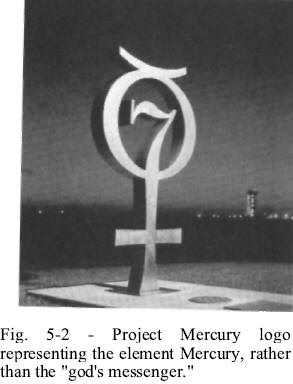
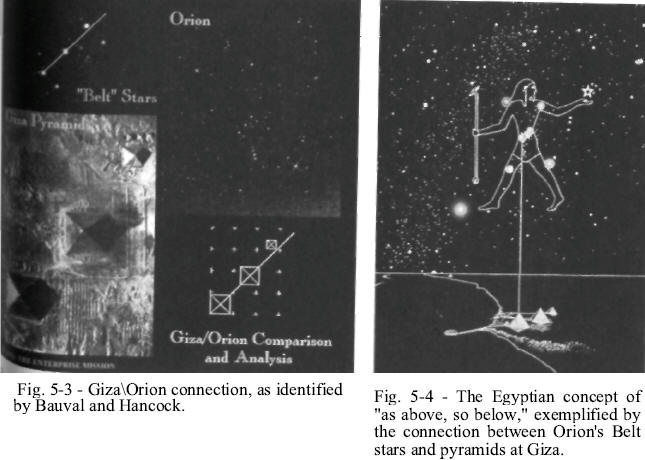
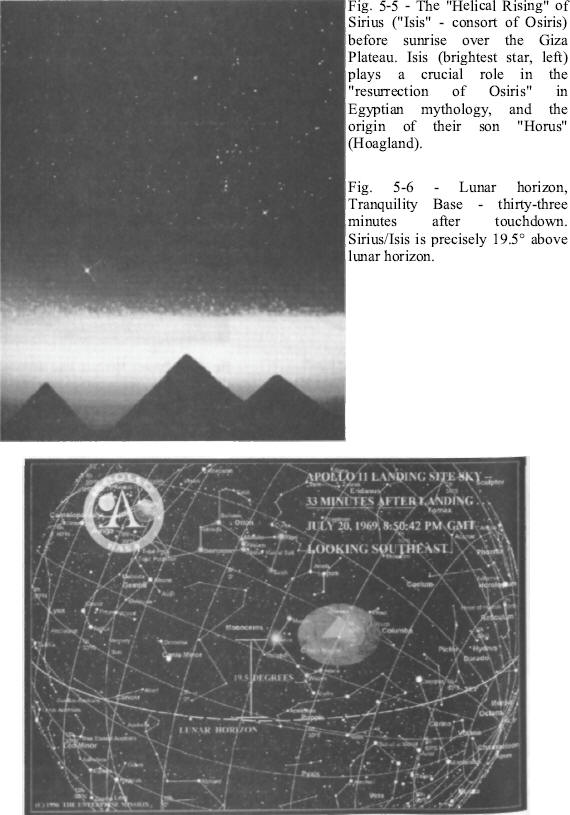
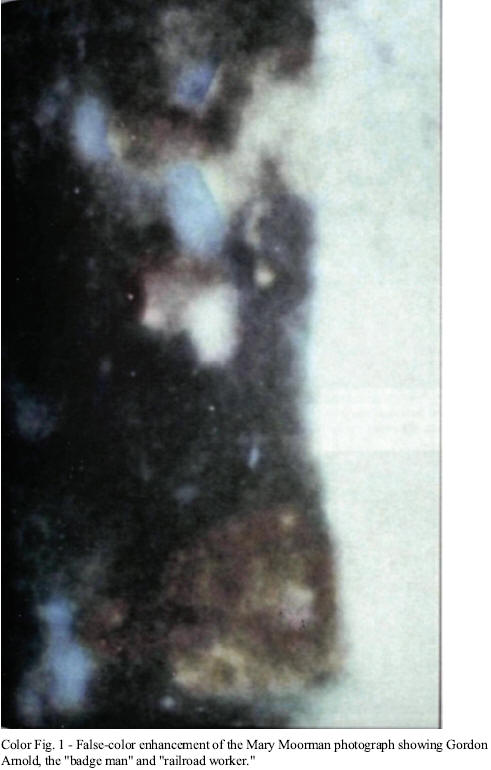
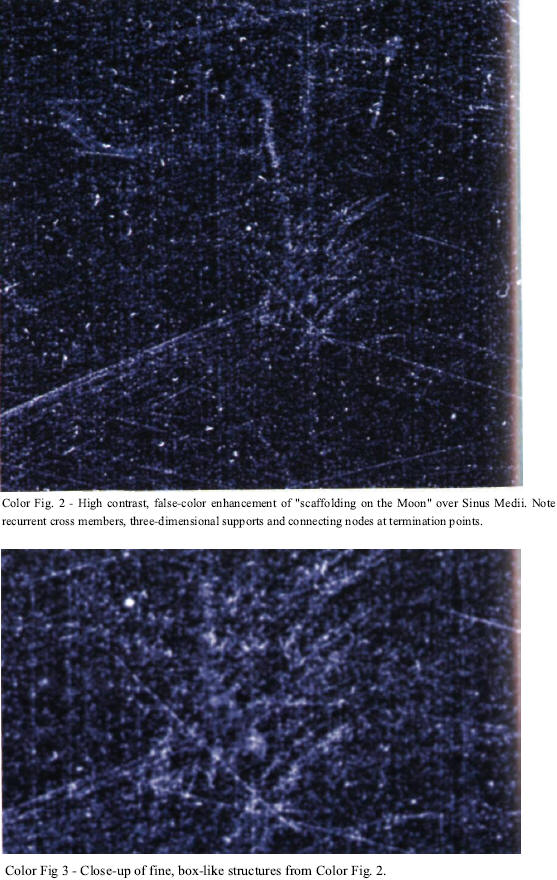

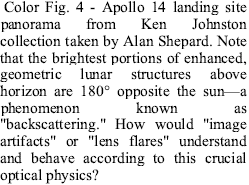
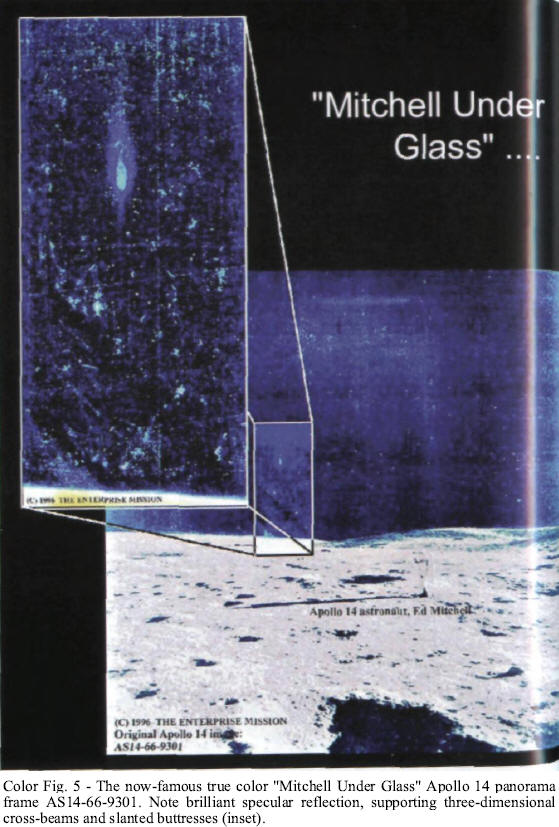
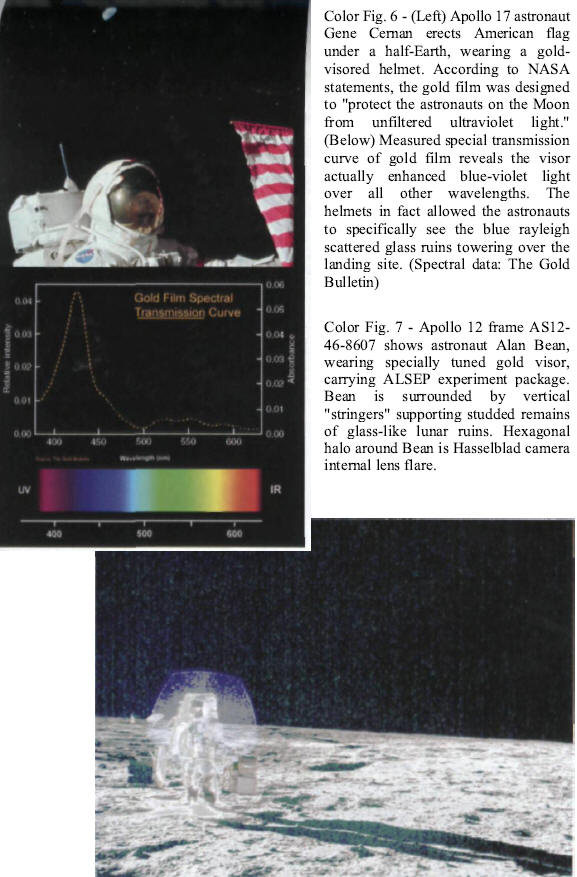
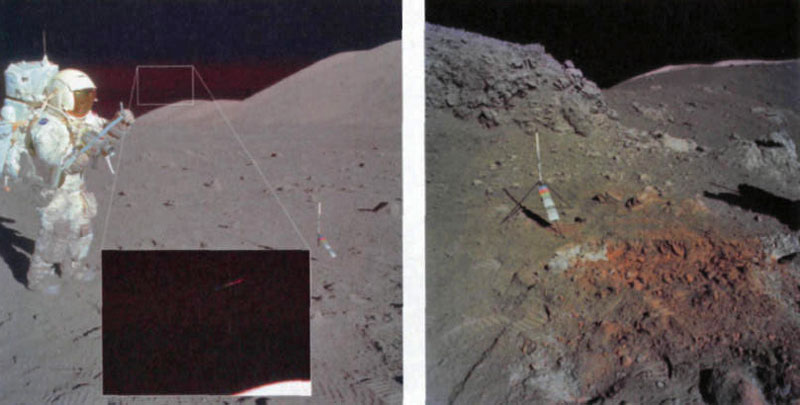
Color Fig. 8 - Gold-helmeted astronaut
Harrison Schmitt
holds collecting rake
while photographed
by astronaut Gene
Cerman. Behind
Schmitt is an
"impossible" lunar
phenomenon - a
backscattered lunar
sunrise. Lunar sunrise
behind Cernan,
refracting
prismatically through
the fragments of glass
structure arching
overhead, is projected
against surviving
glass structure behind
Schmitt. Inset
enlargement reveals one shard of glass reflecting a miniature
rainbow. Color chart confirms accuracy of all colors. (Color
enhancement: Hoagland)
Color Fig. 9 - Color-corrected AS 17-137-20990. Note colors in
background including blue and purple rocks and pink hills due to
refracted sunlight passing through "prisms" of overhead lunar ruins.
Color "gnomon" was placed to ensure proper color calibration of
orange soil found at Shorty Crater.
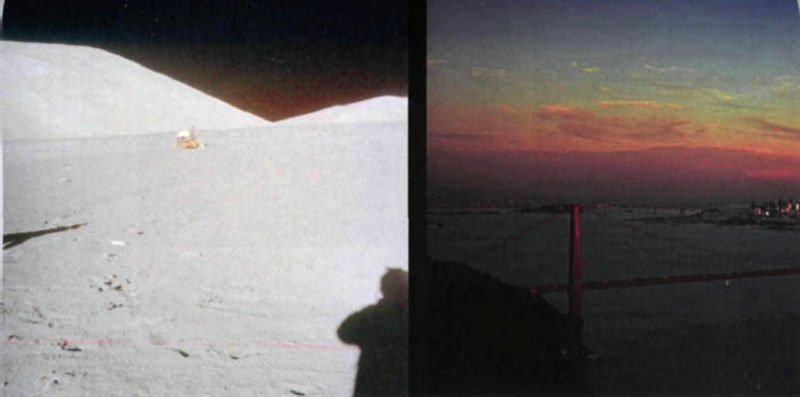
Color Fig. 10-(Left)
AS 17-134-20442.
Apollo 17 astronaut
Gene Cernan
photographs Lunar
Module Challenger
looking West toward
South Massif during
EVA-1. Further
West, the prismatic
display of lunar
sunrise, from a sun
only 13 degrees
above horizon
behind Cernan,
presents an
impossible display
of color against what
should be an
absolute black
background. (Right)
Sunset over San
Francisco Bay
looking East eerily
duplicates Cernan's
lunar scene. Colors
in Earth's
atmosphere are caused by normal atmospheric refraction, so what is
causing the same colors in what NASA says is an airless lunar scene?
Answer: an ancient, refractive lunar dome.
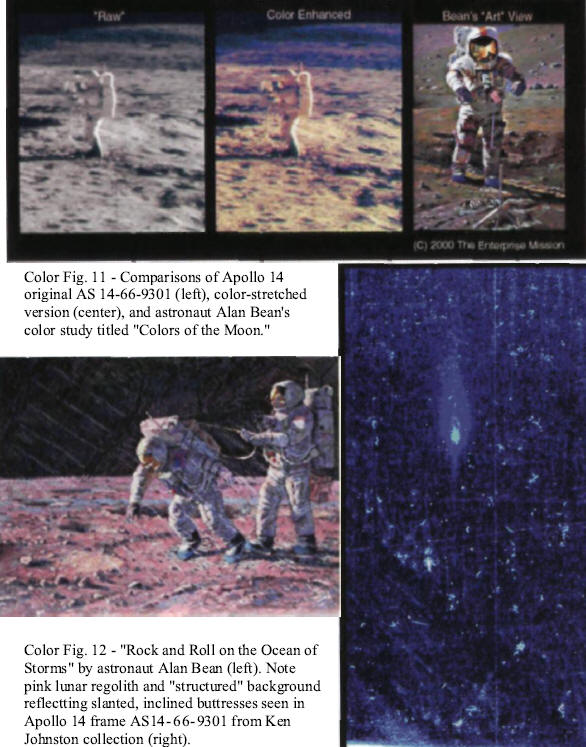
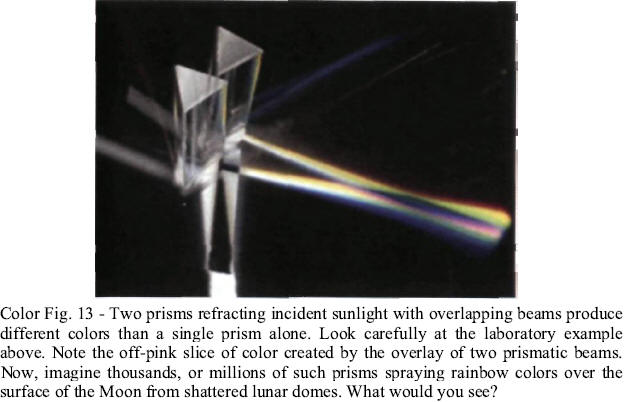
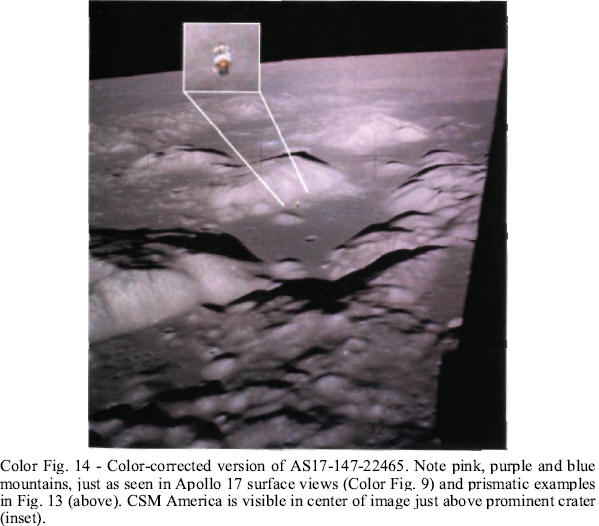
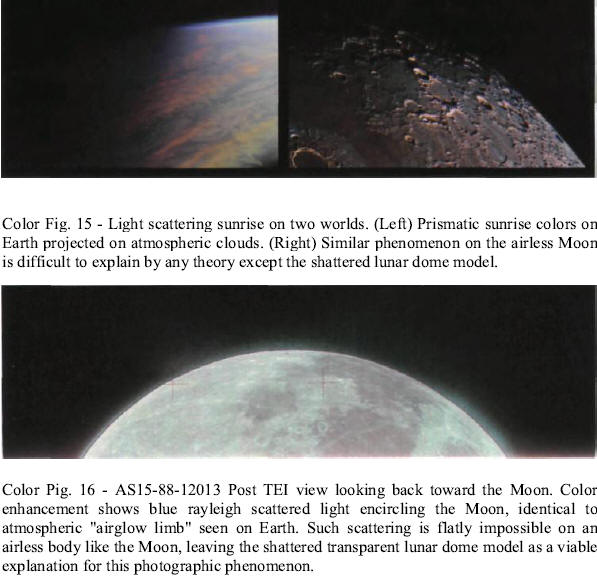
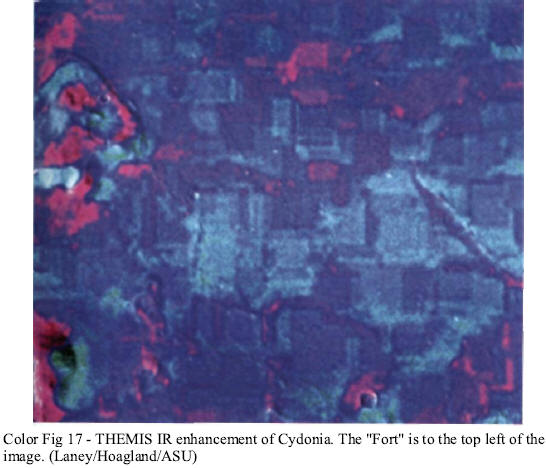
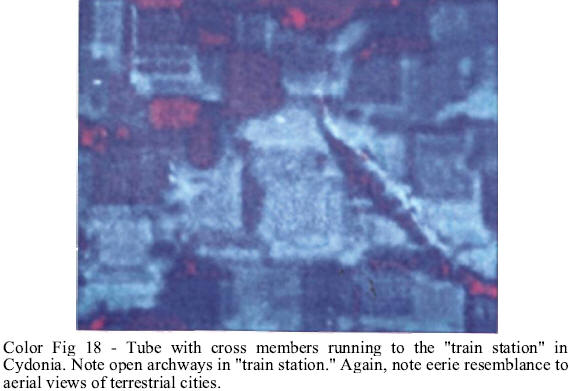
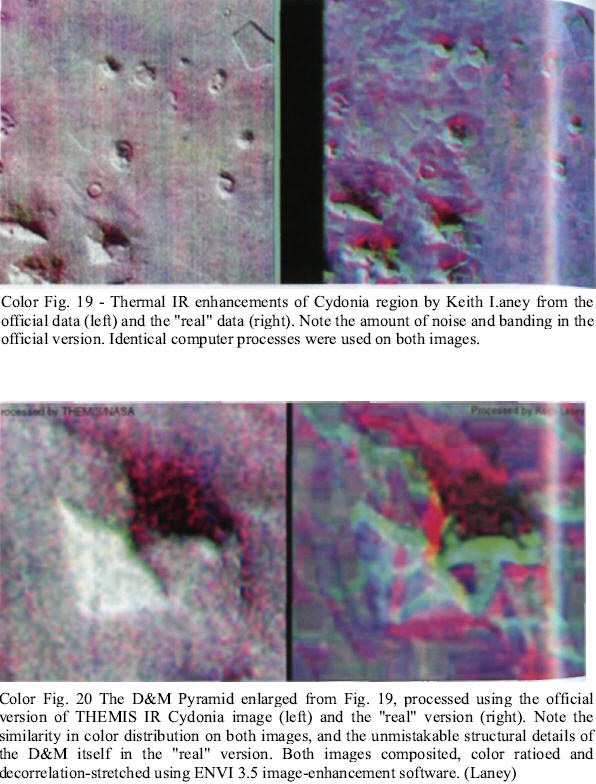
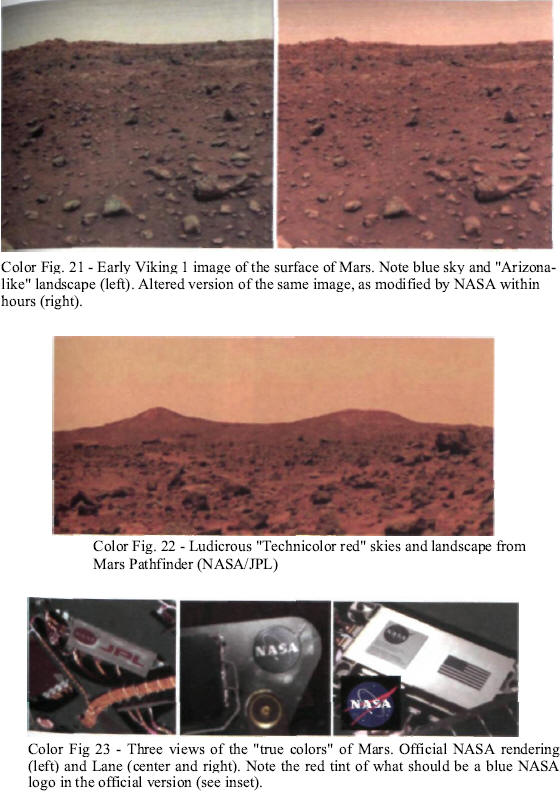
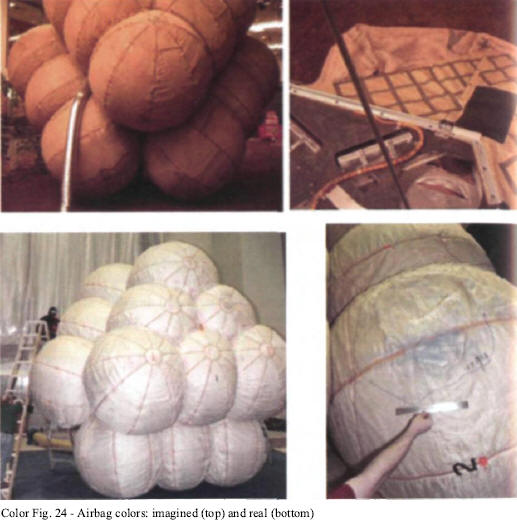
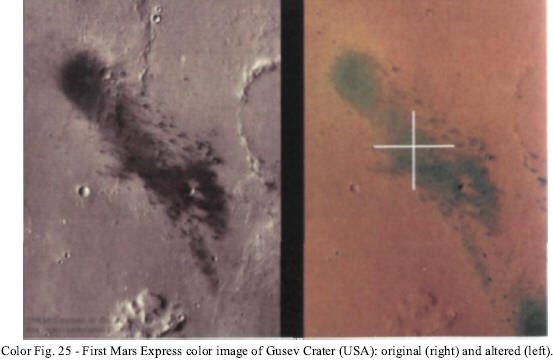
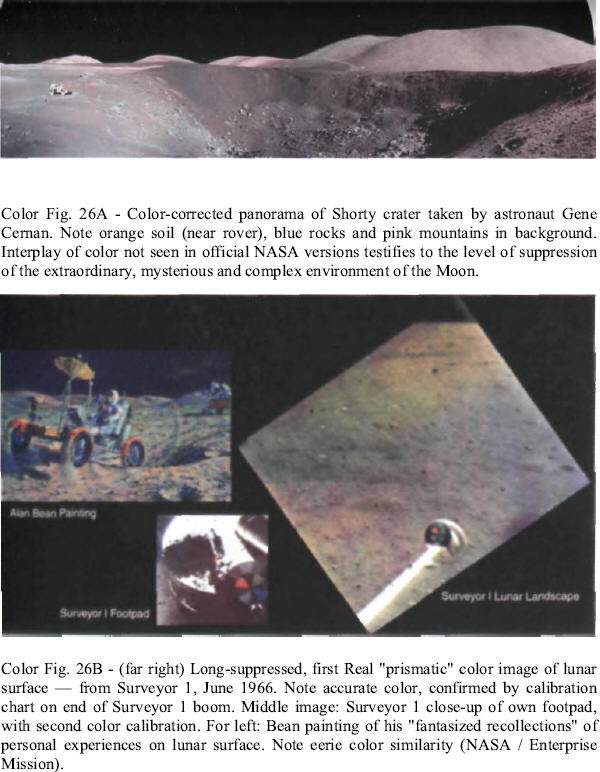
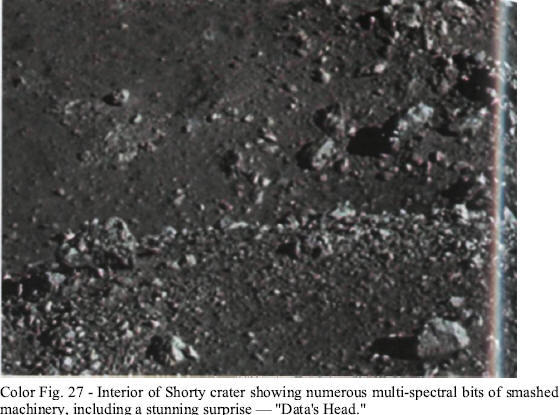
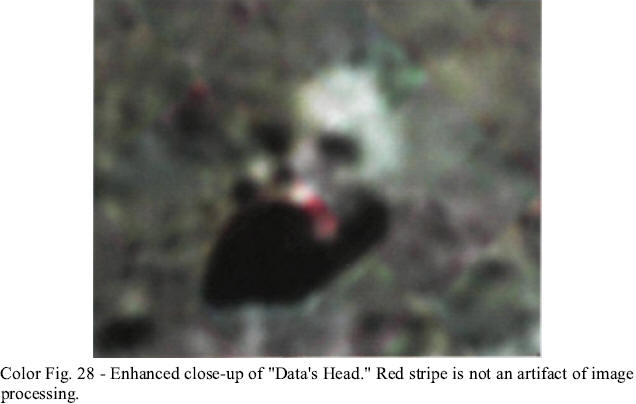
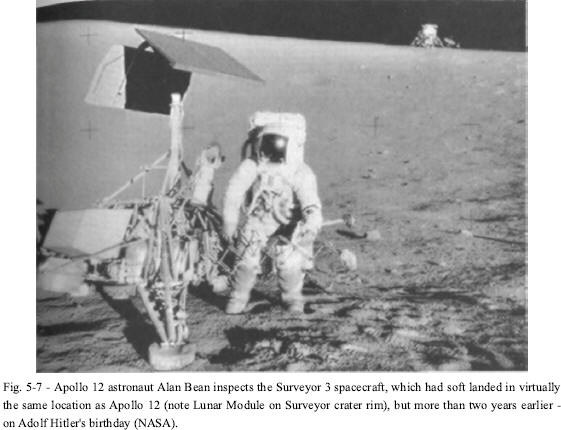
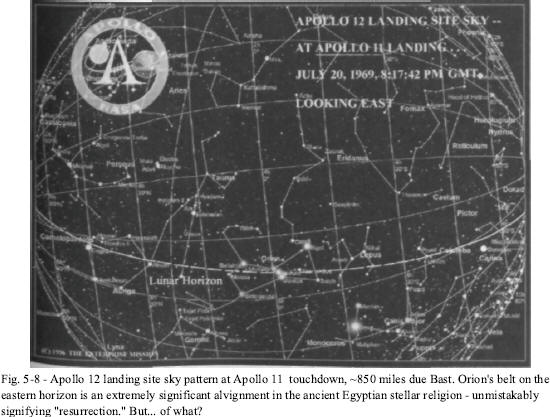
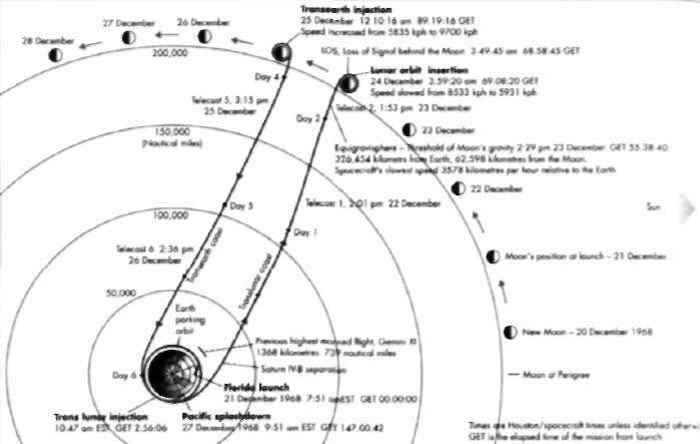
Fig. 5-9 - The celestial mechanics of landing on the Moon and
returning safely to the Earth.

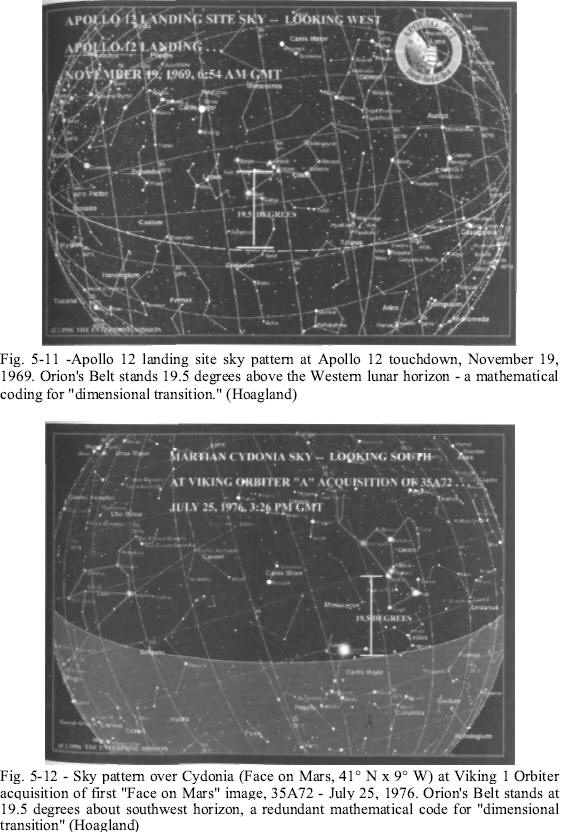
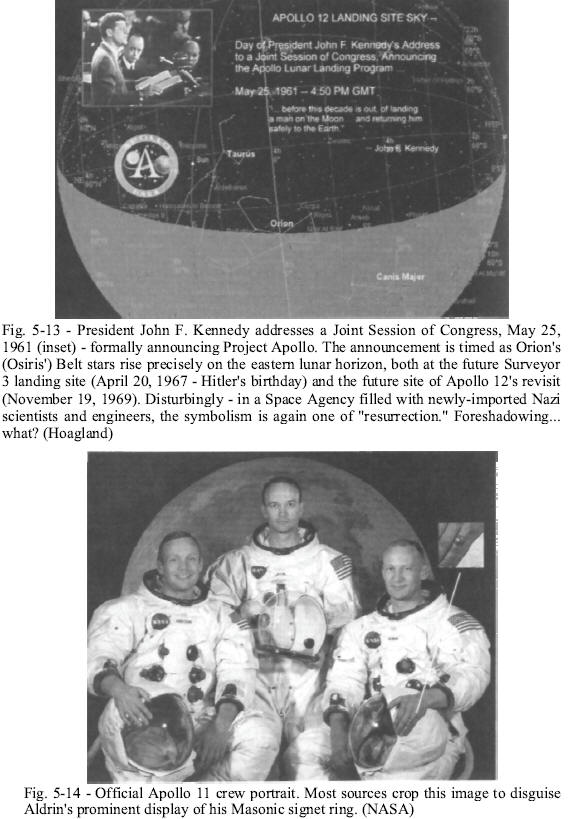
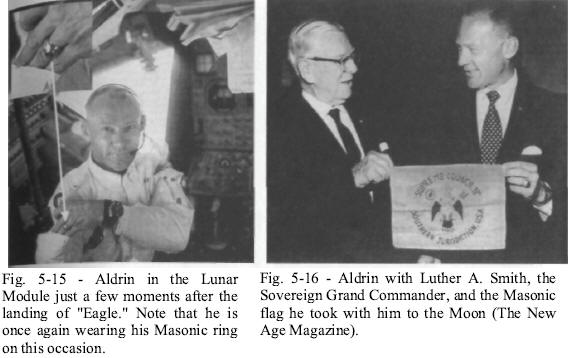
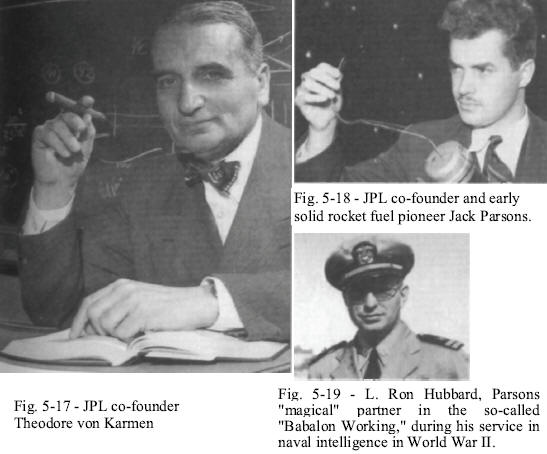
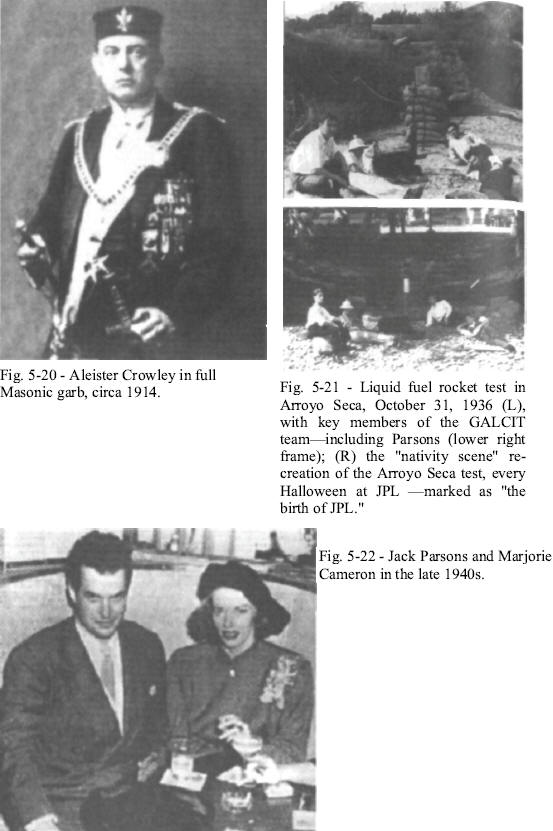
At the time he received Liber 49, Parsons could not have been aware
of certain letters written by Frater Achad,25 which came to light
after Parsons' death.
In them, Achad expressed doubt as to Crowley's
having uttered the Word of the Aeon of Horns because, having
identified himself with the Beast, he was speechless; and in some
inexplicable manner not yet clearly understood the Aeon of Horus
itself has become merged with the Wordless Aeon.
In the Book of
Anti-Christ Parsons wrote, describing the Black Pilgrimage:
"...Babalon called on me again, and I began the last work, that was
the Work of the Wand.
And I worked for 17 days, until Babalon called
me in a dream, in an astral working. Then I reconstructed the
temple, and began the Black Pilgrimage, as She instructed. And I
went into the sunset with Her sign, and into the night past accursed
and desolate places and cyclopean ruins, and so came at last to the
City ot Chorazin.
And there a great tower of Black
Basalt was raised, that was part of a castle whose further
battlements reeled over the gulf of stars. And upon the tower
was this sign
 " "
~ Hecate's Fountain (Grant. Kenneth, Skoob Books Publishing Ltd.
London, 1992)
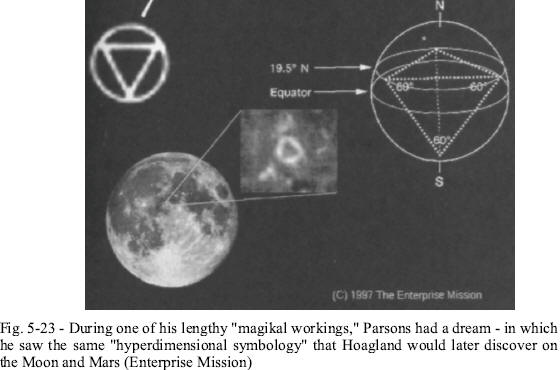
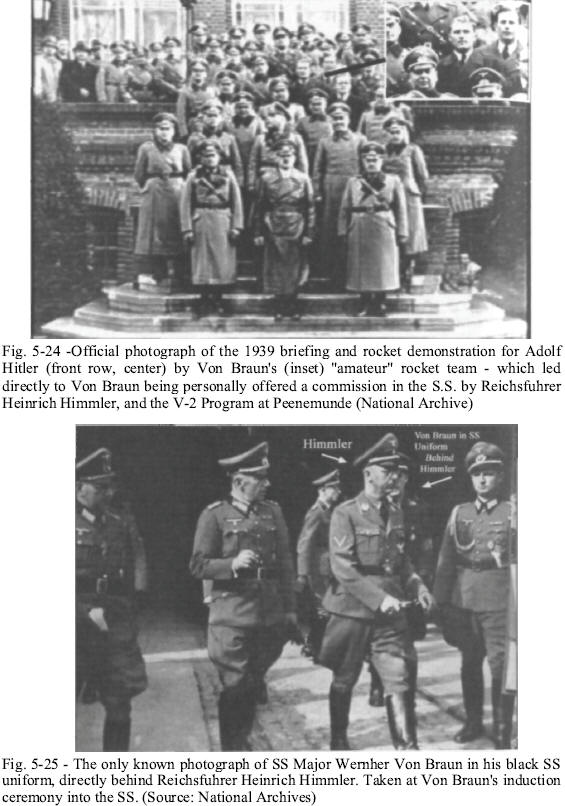
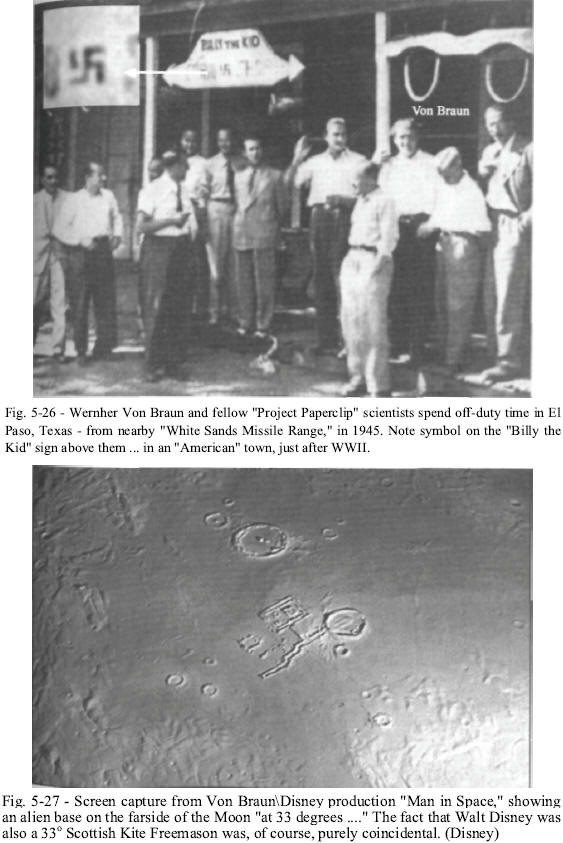
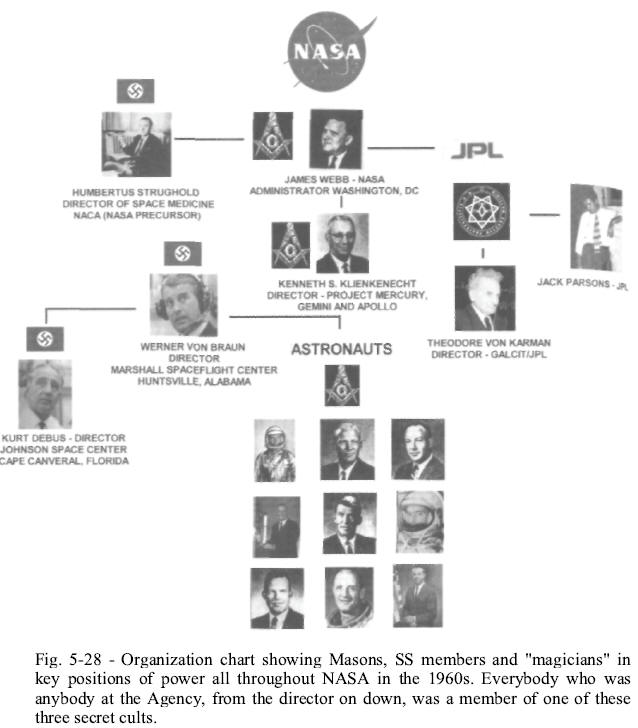
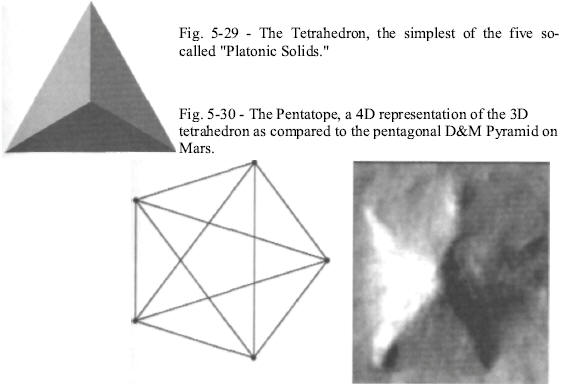
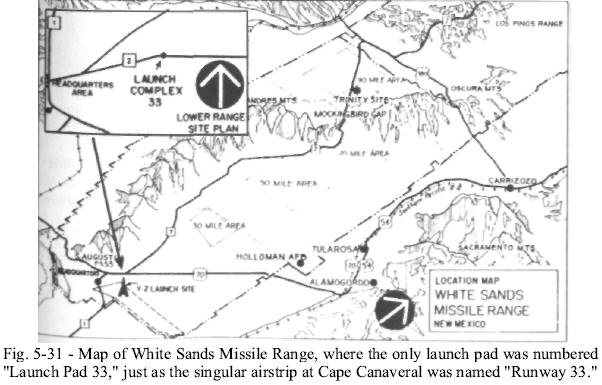
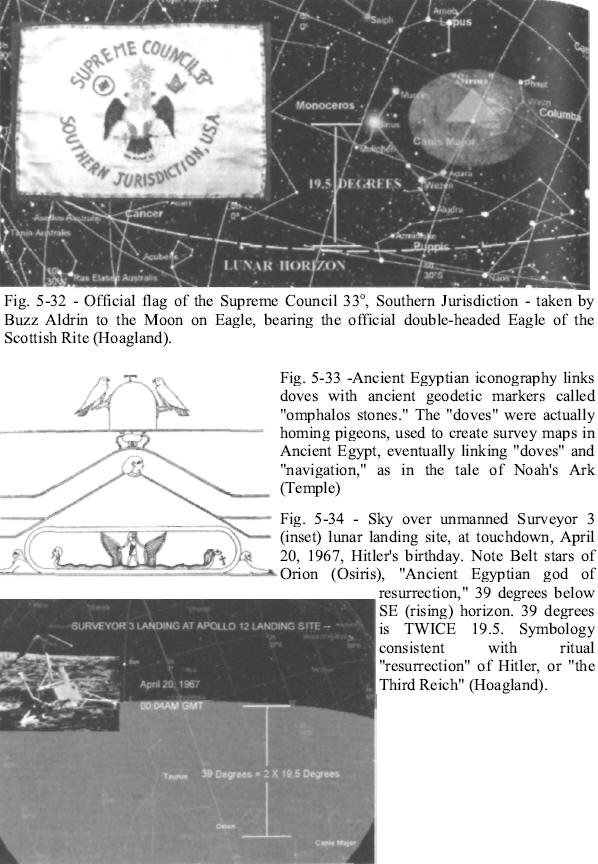
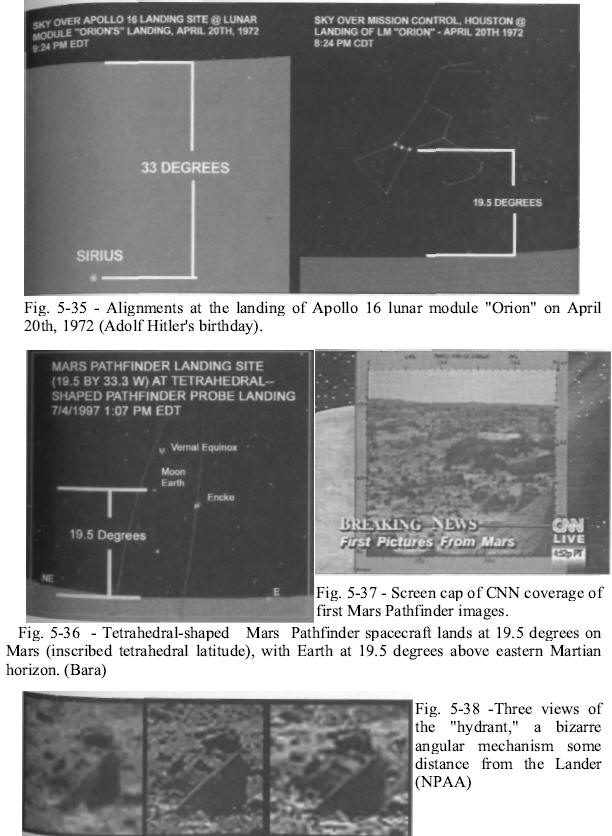
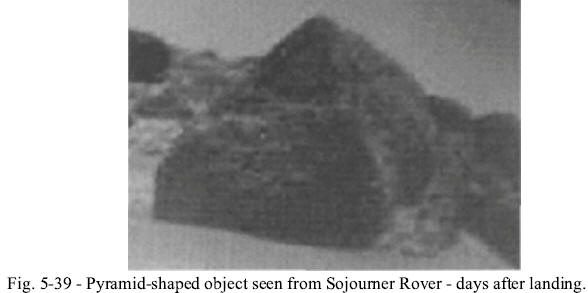
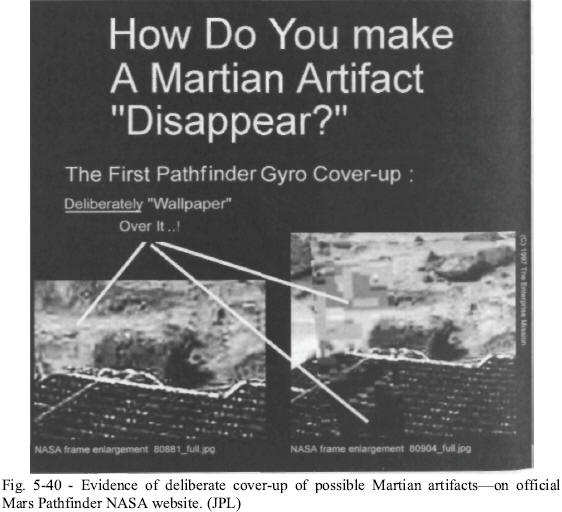

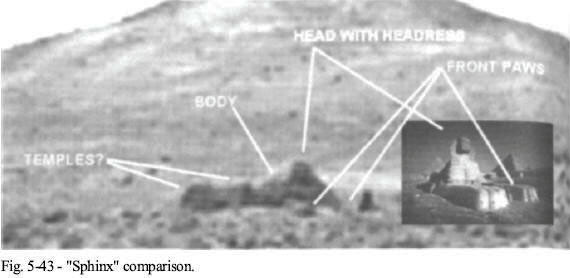
Back to Contents
|


































 "
"










